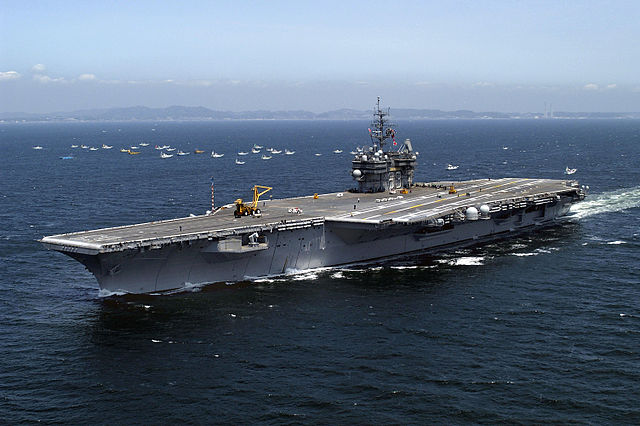
Conventional CATOBAR Aircraft Carriers (1960)
 USS Kitty Hawk, Constellation, America, John F. Kennedy (1955-2009)
USS Kitty Hawk, Constellation, America, John F. Kennedy (1955-2009)
Cold War USN Carriers:
Essex SBC-27 class | Saipan class CVs (1945) | Midway class | USS United States | Forrestal class | Kitty Hawk class | USS Enterprise | Nimitz class | Gerald Ford classAssault Carriers:
Iwo Jima class | Tarawa class | Wasp class | America class | SCS class | VSS classThe Kitty Hawk class aircraft carriers (CV-63-66) were the second “supercarrier” serie and last conventional USN aircraft carriers. In between already was studied an enlarged nuclear-powered version from 1955, which ended with the famous USS Enteprise. In theory, to speed things up, the new class was closely modelled on the previous Forrestal, but with improvements all across the board; In the end, the fourth, lanched years after the others, CV-67 USS John F. Kennedy, was heavily modified and became arguably the finest conventional aircraft carrier of the US Navy to date; Unlike the Forrestals, their modernization was less thorough and late, and they saw the end of the cold war and early 2000s with notable participation in the Vietnam War.
Design Development: Only improved Forrestals ?
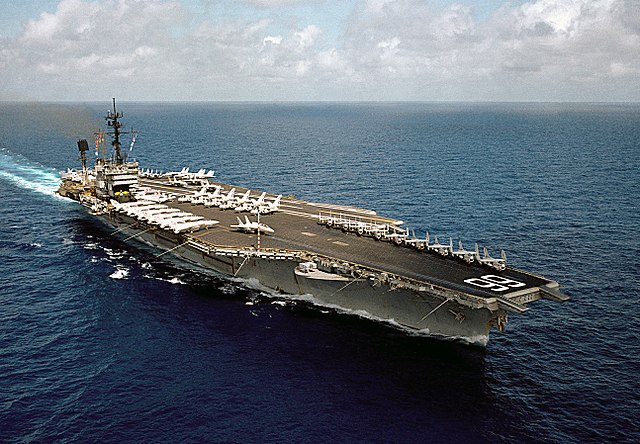
The biggest differences from the Forrestals were their greater length and a different elevators location, as two were forward of the island, one aft and one on the portside stern. These relocations greatly improved the way they could use their angled deck and general aircraft movement aboard. They got rid of the forward-end elevator of the Forrestals, situated both in the landing path and in launch path of waist catapults planes, the biggest issue with the previous design, later eliminated during refits.
Other than that, some improvements were also made in avgas and ordnance stowage, safety, electronics, bridge ergonomics, hangars management, and armament. On the latter chapter, guns were planned but dropped during completion for replacement after commission by the brand new Terrier missile launchers. They were later replaced by the Sea Sparrow, the latter combining anti-air and anti-surface capabilities.
The base design was called SBC 127, and concerned Kitty Hawk and Constellation as SBC-127A, America was completed upon the modified SBC-127C design. Her differences wuth her earlier sisters ships were mostly her anchors with instead of two forward anchors, no port side anchor but an anchor astern, to accommodate the AN/SQS-23 sonar. USS America was indeed the very first USN carrier with a built-in sonar, although removed in the 1980s. Her smokestack was alsio narrower.
Kitty Hawk subclass
At the origin, nuclear tests under the leadership notably of Admiral Zumwalt were leading to its adoption for surface ships even before submarines. While USS Nautilus was launched in 1957, development ended more protracted for the first nuclear powered carrier, USS Enteprise. She was next in line on order (CV-65) after the first two of the Kitty Hawk class, CV-63 and CV-64. Thus, the Kitty Hawk were to be the last two conventional carriers of the USN. But it was not to be due to spiralling costs overruns in the CVAN-65 program.
Cancelled CVAN 66-67 (Enterprise class)
Originally, the next two carriers, CV 66 and 67 were to be ordered as part of the Enterprise class, CVAN-65 nuclear carriers. However ballooning costs of the latter during early construction cause the cancellation of CVAN-66 and CVAN 67. The first was reordered as a conventionally powered Kitty Hawk-class carrier, and soon renamed USS America. The second was pushed even further back to test improvements earned from the early Kitty Hawk service and other ideas and ended as her own separate class, USS John F. Kennedy. She was probably the best conventional carrier ever built in the USN and probably also among the world’s best when she was in service.
Detailed design
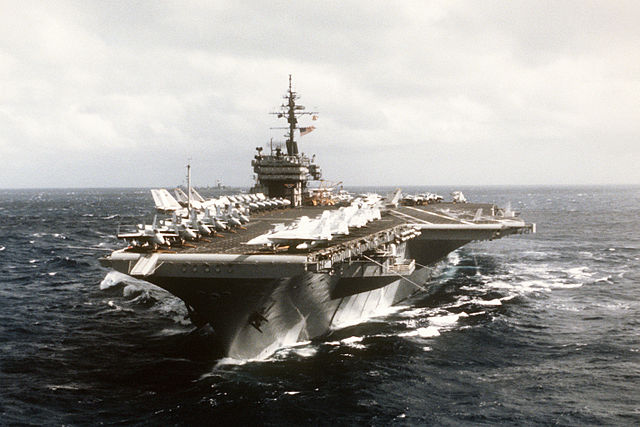
Bow view, CV-64
Hull and Protection
As designed, USS Kitty Hawk displaced 61,351 long tons (62,335 t) standard and 81,985 long tons (83,301 t) fully loaded, a bit more than previous Forrestals. She was also a tad shorter at 1,068.9 ft (325.8 m) overall (versus 1070 ft/326.1 m) but with a much greater overall beam at 282 ft (86 m) extreme on the flight deck, but less than half 130 ft (40 m) at the waterline making for a very favourable ratio of circa 1/9.5. Her draft was 38 ft (12 m) so a meter more than their predecessors. The latter were also slighly narrower at the waterline, at 35 ft 9 in or 39.42 m.
The island design was about the same, relatively large and encompassing the funnel, with two enclosed bridge and an open one, a strong structure with a large mast for electronics platforms. As for protection, it was far less extensive than previous carriers:
SBC-127A (CV63, 64): Four protected decks (144 mm total) with an armored flight deck 1.8 in (45mm) thick, a gallery deck 1 in (25mm), a hangar deck below 1.45 in (37mm) and main deck 1.45 in (37mm), all STS, as on the previous Forrestals. There was a distributed vertical armour which combined with the longitudinal bulkheads made for a total 150 mm like on the previous vessels. The magazines and ammunition, even the avgas tanks had box armour around. Underwater protection had no less than five longitudinal bulkheads of thin armor but the 4th bulkhead was the thickest at 76mm or 3-in and the souble bottom was thicker.
On the slightly miodified CV-66 USS America (SBC-127C) the four protected decks amounted to 151 mm, repartiton as the following: Flight deck 45mm, hangar deck 50mm and main deck 56mm. While the side armor and longitudinal bulkheads were thinner at 135 mm combined. Box-shaped vitals was kept, and the underwater protection was uncharged.
On USS JF Kennedy (CV-67) armour protection for the deck was the same, as the vertical armour, same for the vitals and underwater protection, although it was improved and was the prototype adopted later for the Nimitz class.
Original Plans
Powerplant
Propulsion consisted of four Westinghouse geared turbines, 280,000 shaft horsepower (210,000 kW), four shafts with eight 1,200 pounds per square inch (8,300 kPa) Foster Wheeler boilers. Top speed was 32 knots (59 km/h; 37 mph). Range was 12,000 miles (19,300 km) at 20 kts based on 7,800 tons of oil aboard. This was the same figure for all four carriers, virtually a repeat of the Forrestals.
Armament
The first three ships incorporated a Terrier surface-to-air missile system instead of guns, even in their early stage in 1955. The missiles were combined with the new generation AN/SPG-55 radars, but they consumed a lot of space aboard while duplicating the air defence escorts long range capabilities. They were later removed and replaced by a more balance, short range system. In fact John F. Kennedy missed the Terrier entirely and instead was completed from the onset with the Sea Sparrow Basic Point Defense Missile System (BPDMS).
Later they were replaced by the NATO Sea Sparrow (NSSM) combined with Phalanx CIWS for anti-missile and close defence. In 2001, the last upgrade came into the shape on USS Kitty Hawk in her SLEP overhaul, of two Rolling Airframe Missile (RAM) forward in place of the Sea Sparrow, plus Phalanx CIWS. For active defense, the SLQ-32 Electronic Warfare Suite also installed, as well as on USS Constellation.
RIM-2 Terrier:

Launch of a RIM-2 Terrier from USS Constellation in 1962.
CVA 63 as built had two twin Terrier SAM (80 RIM-2) launchers. This was a monster of a missile, designed to shot down high altitude, high speed soviet bombers (80,000 feets or 24,000 m at Mach 3). The vector weighted 3,000 lb (1,400 kg) overall with booster, comprising the missile at 1,180 lb (540 kg) and its booster at 1,820 lb (830 kg), for a total Length of 27 ft (8.2 m), beam-ruiding and carrying a 218 lb (99 kg) controlled-fragmentation wahread (alt top a 1kT W45 nuclear warhead). In the 1980s it was considered an overkill for air defence as there were already onboard interceptor with long range AA missiles which could do the job. Instead of being replaced by RIM-67 Standard ER (SM-1ER), the much smaller RIM-7 was chosen for USS JFK and added as a supplement on Kitty Hawk in 1977 onwards. USS Constellation kept her Terrier launchers in 1984 after refit, but gained three octuple RIM-7.
RIM-7 Sea Sparrow Mk29:
Due to the large size and complexity of the Terrier, it was cobsidered a light defence system was more desirable for USS John F Kennedy. Thus, the latter adopted in 1969 a battrery of three octuple Sea Sparrow SAM (24 RIM-7). To work, they were coupled with the 6x Mk 95 fire control systems and main SPS-58 radars. Two were added to USS Kitty Hawk in 1977 (16 missiles), with four Mk 95 and two SPS-58 radars. During her 1981 refit, USS America kept her Terrier but was added two twin Standard SM-1MR SAM (80 RIM-66). A year after in 1982 her Terriers were replaced by three octuple Sea Sparrow SAM (24 RIM-7).
RIM-116 RAM:
The U.S. Navy purchased 1,600 RAMs and 115 launchers for 74 ships and the system, outside modernized carriers, also equipped the Nimitz-class and several assault and dock landing ship as well as the littoral combat ships (LCS) today. Designed by General Dynamics/Diehl BGT Defence from 1976, a single system cost was US$998,000 (FY2014). It consisted in a 5,777 kg (12,736 lb) launcher firing eight 2.79 m (9 ft 2 in) missiles, all fitted with a 11.3 kg (24 lb 15 oz) frag warhead. It is powered by a Hercules/Bermite Mk. 36 Solid-fuel rocket.
Operational range is 10 km (6.2 mi) at Mach 2+ (1,500 mph; 2,500 km/h), guidance by passive radio frequency/infrared homing, or infrared only, or infrared dual mode enabled to defeat countermeasures. Accuracy is over 95%. It seems on these ships, the Mk 144 GML was not fitted but directly its replacement the Mk 49 Guided Missile Launching System (GMLS). USS Kitty Hawk was the only one fitted with this system in 2001, in addition to her sea sparrows: Two 21-silos RAM SAM (42 RIM-116).
Phalanx 20mm CIWS:
This one already had been seen in detail oàn the previous Forrestals and can be viewed there.
Electronics
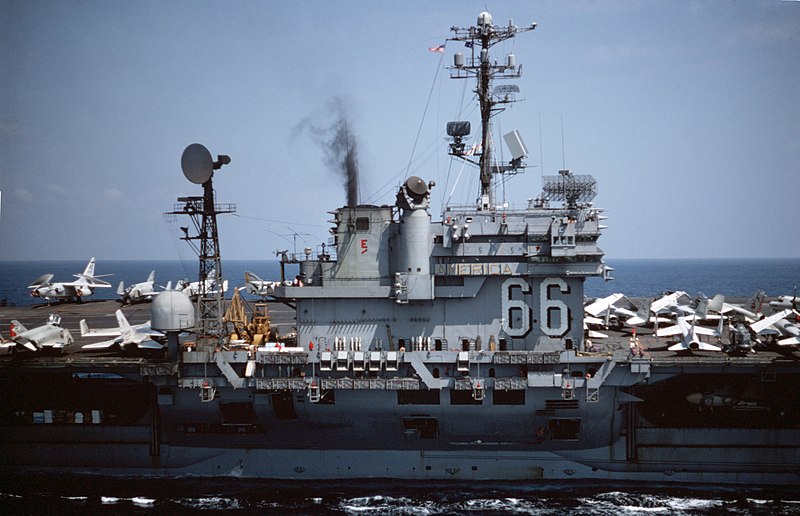
CV-66 island in 1976
During her carrer, CV-66 was the “tester” of most electronics systems: She had the SPS-37A, SPS-39, SPS-30, SPS-43A, SPS-10F, SPN-10, SPN-12, SPN-35 radars as well as two SPG-55 radars (Terrier), SQS-23 sonar, WLR-1, WLR-3, and WLR-11 ECM suites in succession.
AN/SPG-55 radar (terrier)
The designation “AN” stands for “Army-Navy” ans SPG is part of the MIL-STD-196E Designation System for S = Water, P = Radar and G = Fire Control/Searchlight Directing. This Fire control quality three-dimensional data dish-style arrway was not only used in the USN but also the Marina Militare on the Andrea Doria-class cruiser, Giuseppe Garibaldi-class and Vittorio Veneto, all equipped with USN missiles. The AN/SPG 55 supported beam riding Terrier missiles but the upgraded AN/SPG 55A supported homing Terrier missiles.
AN/SQL-32 EW suite
This was the CV specialized version of the CNO family of inexpensive EW suites planned in the early 1970s to replace older systems. It was notabvly a warning system against antiship missile as appeared in the 1967 sinking of Eilath by Egyptian Komar FACs. It was agreed thah both AN/WLR-1 and AN/ULQ-6 systems were unable to perfrom this task. Development started in 1972, and the first prototype was tested in 1977, 1979 on USS Oliver Hazard Perry, and it was installed virtually on every USN major warships. Improvements were implemented starting in 1987. It was available with a standard or DDi console. The system selects the launchers tube, reseed intervals for each engagement while the operator presses the ARM and QUICK LAUNCH FABs to actually launch the decoys. It was replaced by the WLR-11 suite.
AN/SQS-23 sonar
It was only installed on USS America, which had no port side anchor but and anchor astern, and she was the sole U.S. carrier with such feature. It was removed in the early 1980s. The system went back to 1958 and was improved over time but only accepted in 1968. It is a long range, azimuth-scanning search/attack sonar (attack-RDT/SDT, hand-key applications). Although common on DDG-2 and DDG-16 class, data was analysed in the Ship center display (SCD) for and target center display (TCD) for attack. Like the SQS-26 found on many ASW frigates, it had problems.
Flight Deck, Hangar and Facilities
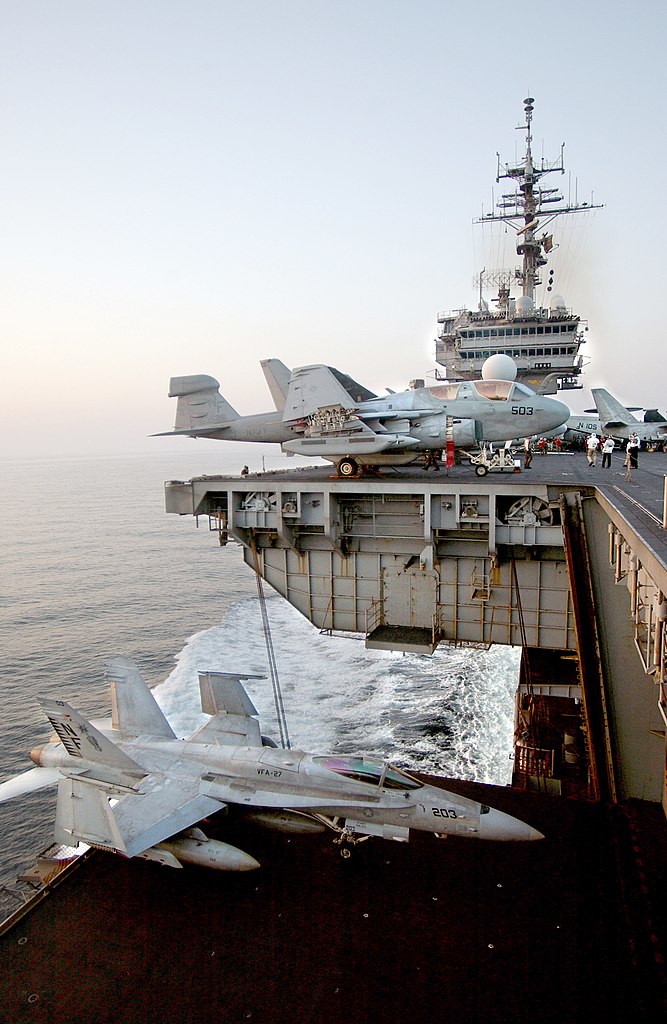
Super photo showing USS Kitty Hawk wing elevator in action
The flight deck was equivalent to the Forrestals in lenght, with an overall 1,069 ft (326 m) long, but far wider, at 282 ft (86 m) extreme as designed, much larger than the Forrestals before upgrades. Forward, there was a total of 20,000 m², or 6,945 m²/52,785 m³ for the Flight deck (310.2 x 73m) with a hangar: 225.5 x 30.8 x 7.60 m. Four deck-edge elevators were 40t in weight, measuring 21.4/25.9 x 15.9m. Launched were performed by four C13 catapults, two forward and two waist ones. Aircraft fuel stowage amounted to 353,500 l of petrol, 6,955,000 liters of highly inflamable JP-5 jet fuel. Aviation ordnance stowage amounted to 1,800t. Their avgaz system was sensitive and often the cause of mishaps and grave fires onboard the ships, in particular aboard USS Constellation.
Vietnam Air Group
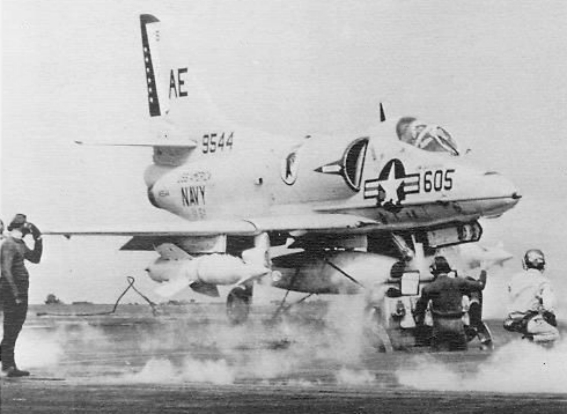
A4-C Skyhawk of VA-64 onboard USS America, prepared to be launched in 1967.
USS Kitty Hawk started her service with twenty four F-4B Phantom II (which became a standard) and twelve F-8E Crusader fighters. She also carried twenty-four A-4C Skyhawk and ten A-3B Skywarrior for attack as well as 12 A-1J/H Skyraiders. She also operated four RF-8G, three RA-3B, three EA-3B, and four E-1B for reconnaissance, and four UH-2A for SAR.
All in all during her career she operated the FJ, F2H, F9F, F3H, F4D, F11F, F8U, F4H fighters, AD, A3D, A4D, A3J attackers, F2H-P, F9F-P, OE, A3D-P, F8U-P, F4H-P recon planes, AD-Q, F3D-Q, A3D-Q ECM planes, AD-W, WF EW planes, S2F ASW planes, TF cargo planes, but also the HRS, HUP, HSS, HUS, HOK, HUK, HUL, and HR2S helicopters.
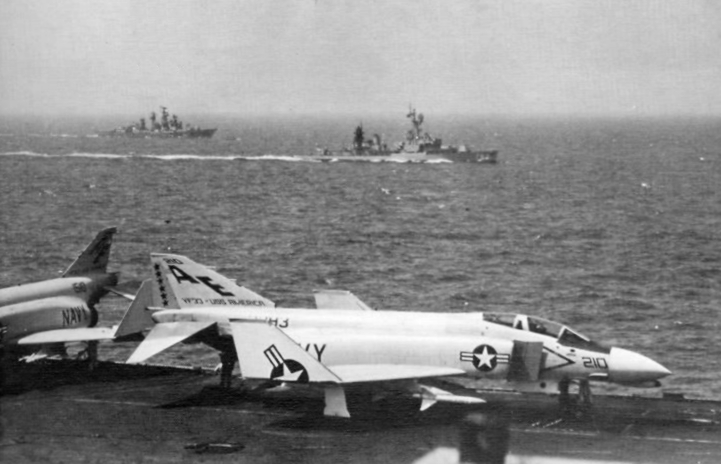
F-4B Phantom II of VF-33 prepared to launch in 1967
USS Constellation in 1974, after conversion as a multirole carrier, had twenty four F-4J and the same of A-7C Corsair attack aircraft, twelve A-6A Intruder and for recce,three RA-5C, four EA-6B Prowler, four E-2C Hawkeye, and four KA-6D, then S-3A viking for ASW warfare, eight 8 SH-3H which were used for SAR and ASW duties.
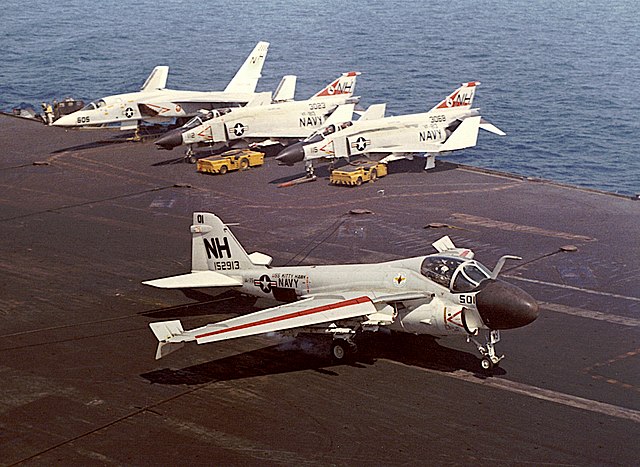
A-6A from USS Kitty Hawk in 1968

NA F4J Phantom II VF-92, USS Constellation
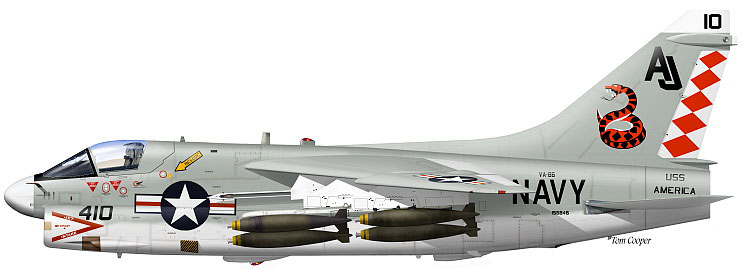
Vought A7E Corsair II VA-86, USS America
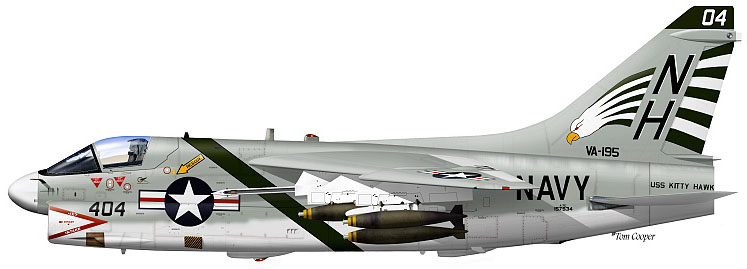
Vought A7E Corsair II VA-195, USS Kitty Hawk
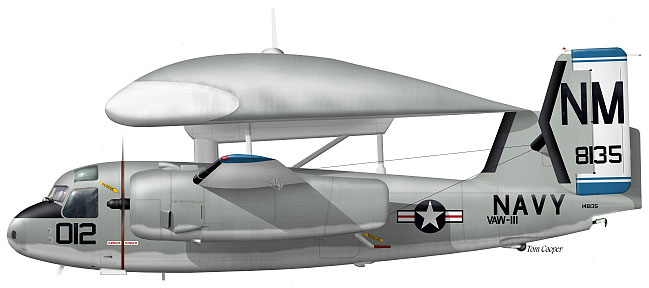
Grumman E1B Tracer from VAW-111
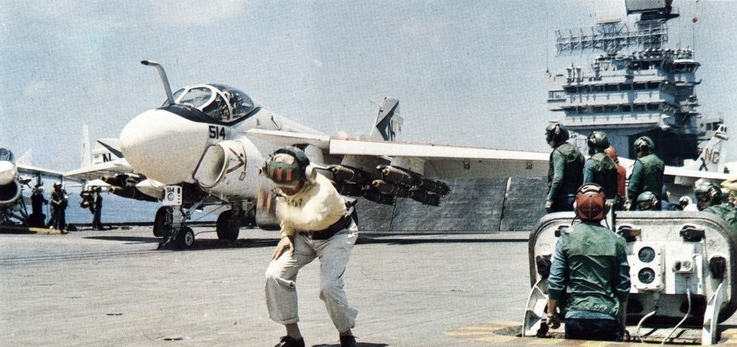
A-6C, VA-165, USS America 1970s
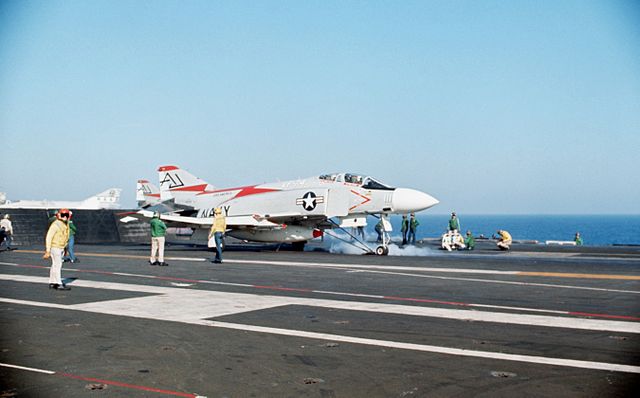
F-4Js VF-74, USS America 1972-73
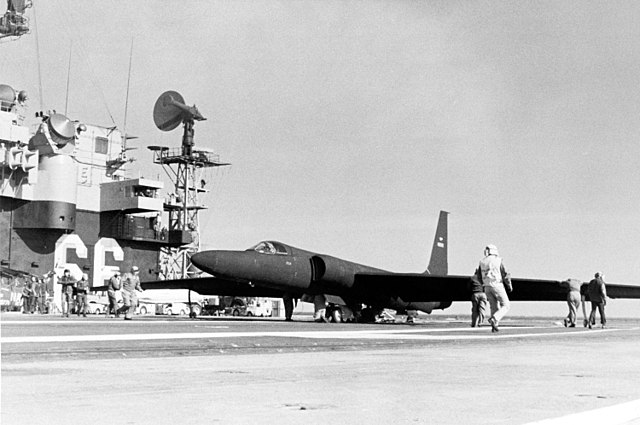
Launch of a U-2 from the deck of USS America
The 1980s air group
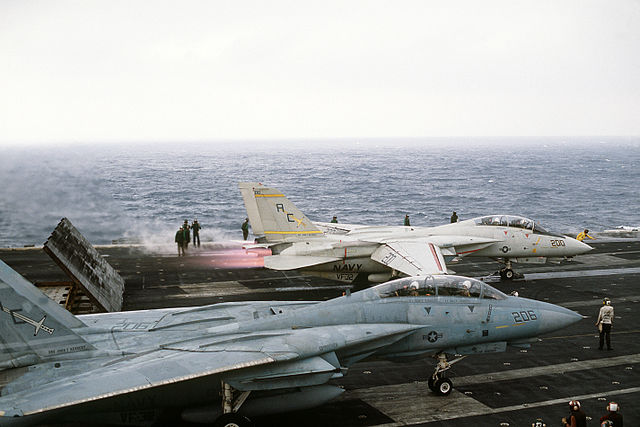
F-14A_VF-32_Exercise_Display_Determination_Mediterranean_1986
In 1988, USS John F. Kennedy operated twenty-four F-14A (in replacement for their Phantom II, zalthough larger, same number was kept for bith escort, interception and CAP), twenty four 24 A-6E Intruder for attack, five EA-6B Prowler and four E-2C Hawkeye for recce, four KA-6D Seasprite helicopters for ASW duties completed by ten S-3A Vikings ASW planes and also eight multirole SH-3H Sea King amphibious helicopters;

F14A, VF-102 USS America

F14A, VF-33 USS America

F14A, VF-32 USS John F. Kennedy

F14A, VF-21 USS Constellation
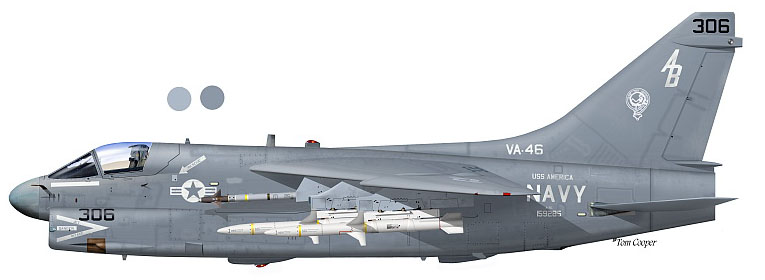
A7E, VA-46, USS America
1990s air group

Grumman A6E Prowler, VA-34, USS America
At the time of the gulf war in 1991, USS America carried the same twenty four F-14A, but also the same number of F/A-18A/B and twelve A-6E/KA-6D ASW helicopters plus eight SAR SH-3H (so 20 helicopters in all) six EA-6B Prowler and four E-2C for recce/EW, plus eight ASW S-3B Viking.

F14A FV-33 USS America, Gulf War, 1991
All profile are courtesy from Tom Cooper, Helion Publishing.
In the 2000s, the air group varied widly but was restricted to fighter/bombers for simplification. Typically in 2006, USS Kitty Hawk and JF Kennedy carried twenty-four F/A-18E/F Hornet abnd the same of F/A-18A/C multirole (taking on attack duties) Hornets, four EA-6B and E-2C as usual and two C-2A cargo planes, as well as six SH-60F/HH-60H Seahawk multitole helicopter.
About the names
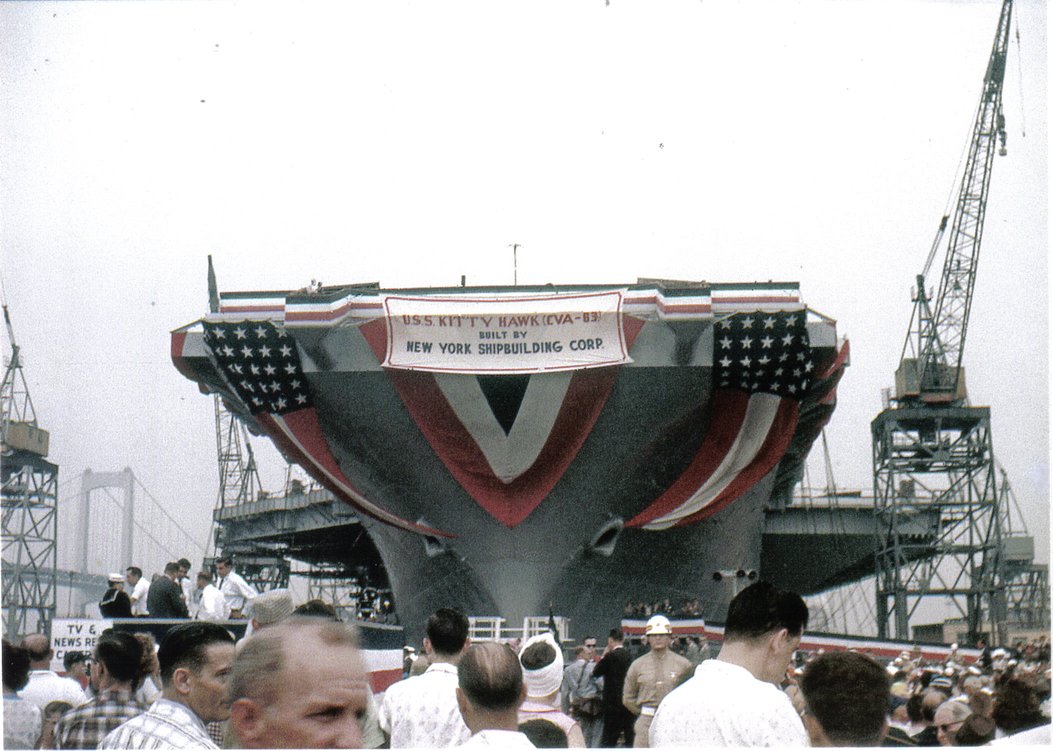
Launch of USS Kitty Hawk in 1961
Like previous vessels, naming convention was more diverse than just naval battles. USS Kitty Hawk honored the start of US aviation by recalling the famous field of Kitty Hawk, North Carolina, site of the Wright brothers’ first powered airplane flight. She was second of the name after a cargo ship on WW2.
USS Constellation, the fastest of all Kitty Hawk carriers and of USN vessels for the matter, honored the Congress “Super-Frigate” launched in 1797 whih really setup the biorth of the US Navy. The name was also carried by a sloop pf war of 1854 whioch took part in the civil war and preserved in 1933 as a National Historic Landmark in Baltimore. The last was a cancelled battlecruiser of the Lexington class started in 1920 (CC-2). The name itself described the stars of the flag. The name was also chosen for a brand new class of frigate as we speak.
USS America was obviously a reference to the continent. The name was sported by a 1782 74-gun ship of the line, a 19th-century racing yacht converted during the Civil War and the captured German ocean liner SS Amerika.
CV-67 was named in hommage of the 36th president of the USA, assassinated on 11 November 1963 in Dallas. She was ordered under that name on 30 April 1964 and the first USN ship to be so. After she was discarded, CVN-79, a Gerald R. Ford-class aircraft carrier launched in 2019 and in completion, is the second vessel named after him. Her latin motto was “Date Nolite Rogare” or “Give, do not ask” and Unofficially she was called “Big John” but also “Can Opener” or “Jack the Tin Can Killer” due to her numerous collisions at sea.
Construction
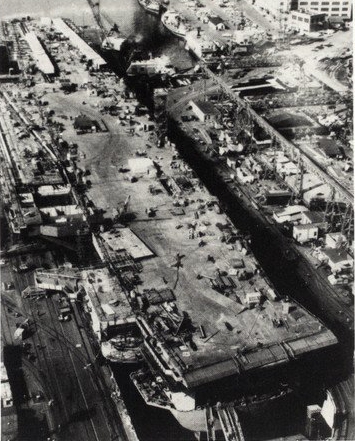
USS Constellation under construction in 1960. It was devayed by seven months after a fierce fire. She would have two more in her career earning her the unnofficial “Hot Connie” moniker. Nevertheless, she ended as the most decorated carrier of the Vietnam war.
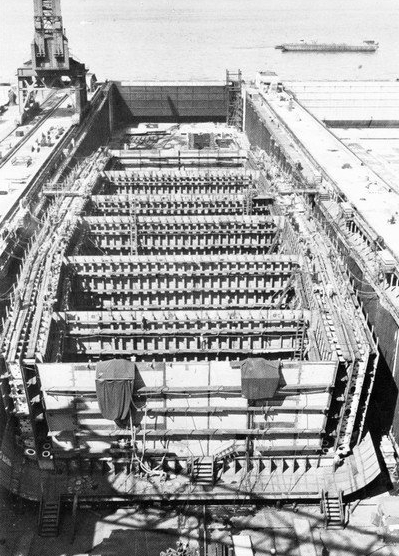
USS America under construction at Newport News in 1961, early phases, showing her internal bulkheads and double hull. Next the gigantic turbines will be installed. Replacing them during SLEP was a daunting task.
-USS Kitty Hawk was ordered on 1 October 1955, the first of two built in New York Camden yard, laid down on 27 December 1956 and launched on 21 May 1960, then completed on 29 April 1961. She was also the last decommissioned, in 2007, two years after JF Kennedy…
-USS Constellation was also ordered to New York shipyard, but not Camden as her sister, on 1 July 1956. Laid down on 14 September 1957 she was launched on 8 October 1960 and comlpleted on 27 October 1961.
-USS America was laid down on 1 January 1961 at Newport News, Virginia, buult by Newport News Shipbuilding and Dry Dock Corp. She was launched on 1 February 1964, sponsored that day by Mrs. Catherine McDonald, wife of Admiral David L. McDonald, Chief of Naval Operations. She was commissioned at Norfolk Naval Shipyard, 23 January 1965. But she was also the first decommissioned, in 1996.
-USS John F. Kennedy was awarded on 30 April 1964 to Newport News Shipbuilding, laid down on 22 October 1964, launched on 27 May 1967 (Sponsored by Caroline Kennedy) and Christened by her mother, and Commissioned on 7 September 1968.
⚙ Kitty Hawk class specifications 1960 |
|
| Dimensions | 990 (wl) x 130 x 38 ft (300m x 40m x 12m) |
| Fight Deck | 1,069 ft × 282 ft (326m × 86m) |
| Displacement | 60,933 long tons light, 81,780 long tons fully loaded |
| Crew | 5,624 total, 2,764 + 1,912 (Crew, Air Staff), see notes |
| Propulsion | 4 GS HP turbines, 8 Babcock boilers, 280,000 hp (210 MW) |
| Speed | 34 knots (63 km/h; 39 mph) |
| Range | |
| Armament | 24× Sea Sparrow/RIM-116 RAM, 3–4× Phalanx CIWSs |
| Air Group | 90 planes, see notes. |
| Electronics | SPS-8,10,12 radars, SPN-6,8,12, FCS Mk 35, SLR-2 ECM |
| Protection | Belt 6 in, flight deck 2 in, gallery deck 1 in, hangar and main deck 1.5 in, torpedo bulkhead 3 in |
The variant: USS John F Kennedy (CV-67).
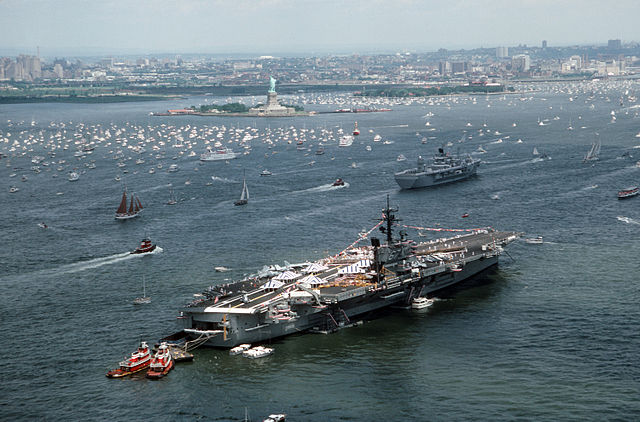
USS John F. Kennedy at the New York Parade, 4 July 1986
USS John F. Kennedy was originally scheduled to be the fourth carrier of the class, but because she received so many modifications under the SCB 127C program, she ended as her own sub-class. So much so many publication list her as an entirely separate class. USS JF.Kennedy had the same design changes concerning her anchors placement to accommodate a fixed improved sonar array, but the latter was never installed.
The nuclear power conversion SCB 211A was considered and planned, but never authorized by the Congress. JF Kennedy’s smokestack is different also, tilting outboard to further push smoke away from the flight deck. Her angled end at the waist was also revised and different from from previous carriers, and the fruit of early studies planned for the Nimitz class. Se was 17 feet (5.2 m) shorter overall in lenght.
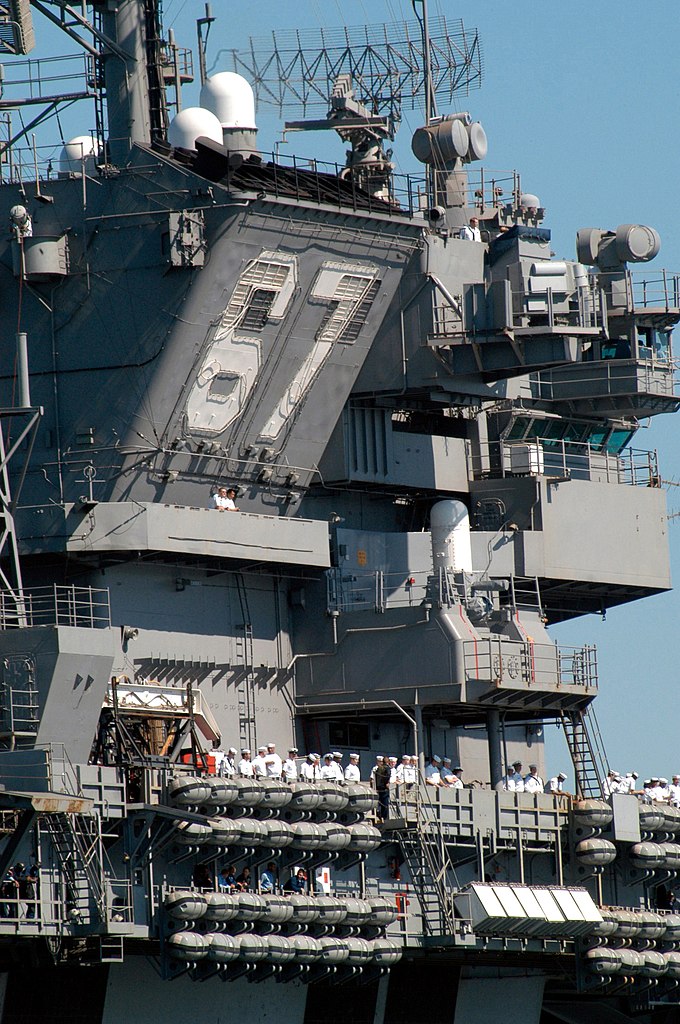
Outboard island in 2004
These were only the most visible differences. Countless details were also improved. Since she was completed after USS Enterprise, she was also a prototype in some way for the future Nimitz class. Indeed she was completed on 7 September 1968, seven years after CVN-65. USS Nimitz was laid down earlier, on 22 June 1968 and studied were greatly influence by all lessons applied to CV-67.
Major Refit: SLEP 1980-88
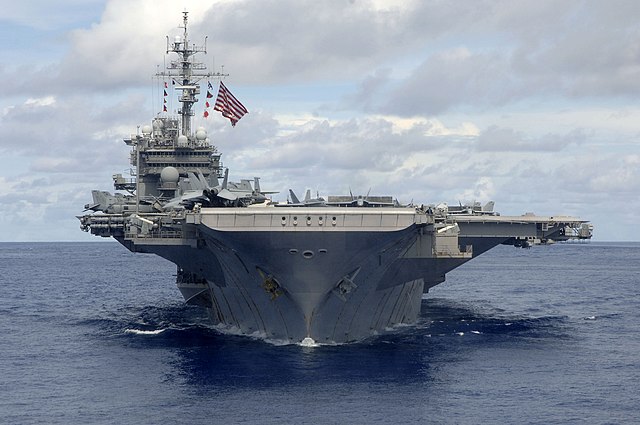
USS Kitty Hawk’s bow in 2007
In 1987-1991 USS Kitty Hawk underwent her major overhauled, at a cost of $785 million, later than the older Forrestals, but under a slightly revised version of the “Service Life Extension Program” (SLEP) at Philadelphia Naval Shipyard. In 1990-1992, this was the turn of USS Constellation, but it was even costier (inflation adjusted) at $800 million also at Philadelphia despite being shorter in span. Both were intended to give thel an extra 15 years of active service.
John F. Kennedy escaped SLEP as alreay way improved over her sister and instead had a 1993-1995 overhaul costing $491 million, also in Philadelphia befiore the yard went bankrupt. USS America was scheduled after Constallation for the same but the post-coldwar budget cuts saw her decommissioned instead of 9 August 1996. Anyway, a team determines that she was in very poor condition. Like her sisters she was considered for a donation as floating museum but this was never carried out and she ended as live-fire target and sunk as artificial reef on 14 May 2005.
UNN Constellation was in service again from 1992 to 2003, so less than the 15 years planned, as the Congress estimated her yearly operational maintenance cost. So she was decommissioned earlier than expected, on 7 August 2003. John F. Kennedy was decommissioned just three years afterwards on 23 March 2007. Her too, did not exploited her last overhaul to the full. USS Kitty Hawk, the oldest of them all, paradocically, remained in service until 2008. She was indeed in the best conditions, somewhat preserved by her partial status as schoolship. She was eventually replaced by USS George Washington for the permanent naval station in Japan. Back to the US she was decommissioned on 12 May that year.
⚙ Kitty Hawk class in the 1990s |
|
| Displacement | 65,000 tons tons standard, circa 79,000 tons Fully Loaded |
| Crew | 4,378 |
| Armament | 3×8 Sea Sparrow SAM Mk29, 3×20 mm CIWS Mk.15 |
| Electronics | SPS-29,37A/43A, SPS-30 radars, SPS-58 for sea sparrow, WLR-1, WLR-3 ECM |
| Protection | Kevlar add-on plates in some areas |
A long cold war career
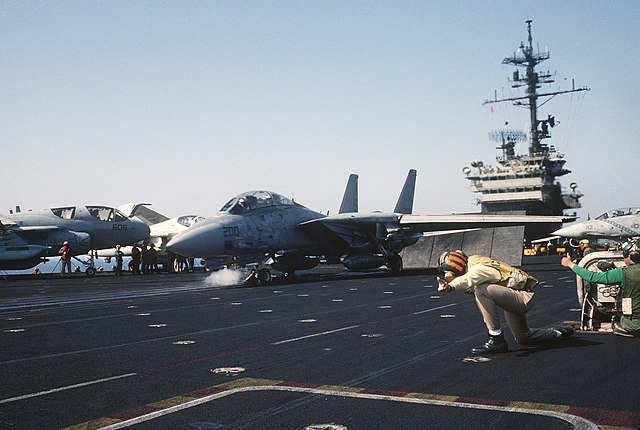
USS America prepares to launch a F-14 Tomcat off the coast of Libya in 1986
Commissioned in 1961-1968, the Kitty Hawk-class supercarriers Kitty Hawk (CV-63), Constellation (CV-64), America (CV-66) and the John F. Kennedy (CV-67) variant took part in the Vietnam War, and middle east crisis, frolm the 1967 war to the Gulf war.
-USS Kitty Hawk, saw Vietnam (7th fleet) deployment in 1961 to 1964 and 1965 to 1972. Mediterranean deployments in 1973-1977 and 1979-1998. She was still active until 2008, but did not took part in the 1991 gulf war.
-USS Constellation suffered a fire during construction. She made deployment in 1960–1969 (Vietnam) and 1970–1979 middle east. An era marked by Black sailor protests. She served in various crisis until the 2000s.
-USS America took part in two First deployment (1965–1966), a third in 1967, followed by a Mediterranean TOD, for the Crisis in the Middle East, between the Six Day War and the attack on USS Liberty. Her Atlantic and Mediterranean Service was followed by a second Vietnam War deployment, a third, until 1973. The 1980s saw the Crisis in Lebanon, Crisis in Libya, Libyan retaliation, Operation El Dorado Canyon and the Persian Gulf War with Operations Desert Shield and Desert Storm.
-USS John F. Kennedy was the only one never deployed in Vietnam. Instead she served mostly in the Mediterranean and Atlantic. Her middle east commitments were pareticularly intense in the Middle east crisis of the 1980s. She took part also in Operation desrt Storm in 1991 and continued to serve in the Naval Reserve Force before taking part in Operation Enduring Freedom, her last major deployment.
Links/Src
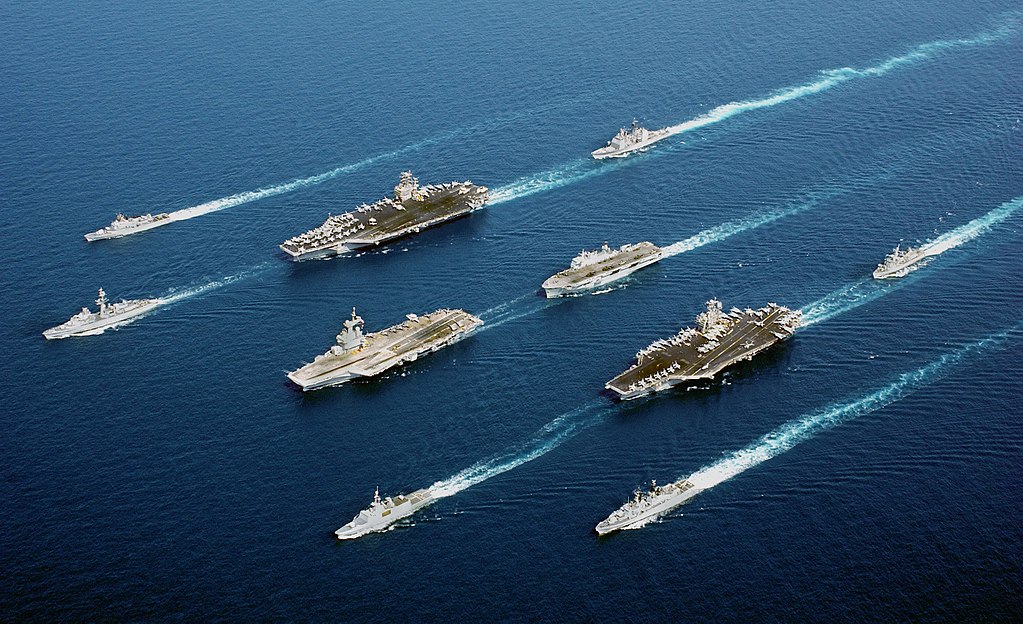
The 5 nations fleet, 2002
Books
J.Gardiner, R. Conway’s All the World’s Fighting Ships, 1947–1995
Donald, David; Daniel J. March (2001). Carrier Aviation Air Power Directory. AIRtime Publishing
Cracknell, W.H, Warship Profile 15, USS Enterprise (CVAN 65) Nuclear Attack Carrier
Friedman, Norman (1983). U.S. Aircraft Carriers: An Illustrated Design History. Annapolis, Maryland: Unite
Miller, David; Miller, Chris (1986). Modern Naval Combat. London, New York: Salamander Books.
Huddy, Doug (25 July 2001). “USS Kitty Hawk gets upgrade with Rolling Airframe Missile weapon system”. Stars and Stripes.
Naval Sea Systems Command Office of Corporate Communications (23 November 2009). “Navy Announces Availability of ex-John F. Kennedy for Donation” (Press release).
Hollman, Laurie (31 July 1991). “A somber farewell to the Kitty Hawk; the job done
“Shipyard’s Closing Uproots 4,400 Workers: Philadelphia Naval Shipyard Scheduled To Close Sept. 15”. The Plain Dealer. Cleveland, Ohio. Associated Press. 2 May 1995. pp. 12.C.
United States Navy. Kitty Hawk Command FAQ. Accessed 12 January 2008.
“USS Kitty Hawk, Navy’s Oldest Active Ship, Leaves Japan to Be Decommissioned”. Fox News. 28 May 2008.
Miller, David; Miller, Chris (1986). Modern Naval Combat. London, New York: Salamander Books.
Huddy, Doug (25 July 2001). “USS Kitty Hawk gets upgrade with Rolling Airframe Missile weapon system”. Stars and Stripes.
“AN/SLQ-32 Electronic Warfare (EW) system”. fas.org. 30 June 1999. Retrieved 4 May 2016.
Naval Sea Systems Command Office of Corporate Communications (23 November 2009). “Navy Announces Availability of ex-John F. Kennedy for Donation”
Hollman, Laurie (31 July 1991). “A somber farewell to the Kitty Hawk; the job done, the carrier leaves. But clouds hang over the yard”. Philadelphia Inquirer.
“Revamped Aircraft Carrier Sails For 10-Day Sea Trial”. Orlando Sentinel 7 November 1992.
“Shipyard’s Closing Uproots 4,400 Workers: Philadelphia Naval Shipyard Scheduled To Close Sept. 15”. Associated Press.
“USS Kitty Hawk, Navy’s Oldest Active Ship, Leaves Japan to Be Decommissioned”. Fox News. 28 May 2008. Retrieved 4 May 2016.
Links
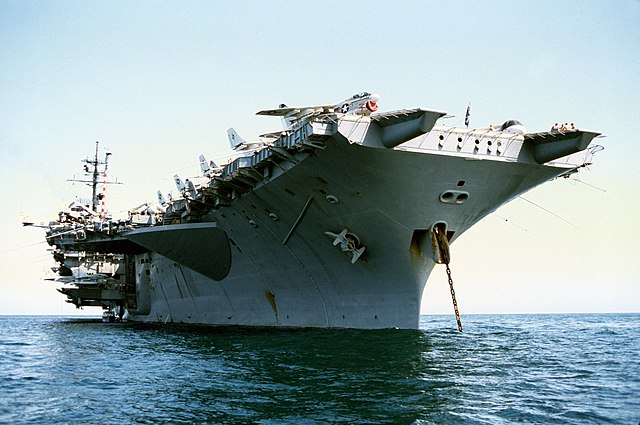
USS_America_CV-66_low_view_of_stbd_bow
Full Plans sets, 1973
CV 59 on Navsource
On globalsecurity.org
The class on hazegray.org
Navypedia (archive)
About USN radars
Litty Hawk class
AN/SLQ-32 Electronic Warfare (EW) system
Nimitz class
USS JF Kennedy
USS Enteprise
wiki
Model kits

kitty hawk class on scalemates
Popular subject, especially in the 1960s. Trumpeter for example covered it in 1:350 and 1:700, Merit International to 1:350, Fujumi 1:700, Academy 1:800.
USS Constellation (CV-64) was covered by Italeri 1:720 but aso the same as above plus AODA Hobby to 1:800, ARII 1:800, Otaki 1:800, Revell Monogram 1:1450.
USS America also, but with Testors 1:720 and Kitek to 1:800 also. JF Kennedy was covered by Merit International 1:350, Academy 1:800 and Academy/Minicraft 1:800.
USS America CVA-66/CV-66 Book Detail & Scale Nr. 34 Bert Kinzey
 USS Kitty Hawk (CV-63)
USS Kitty Hawk (CV-63)
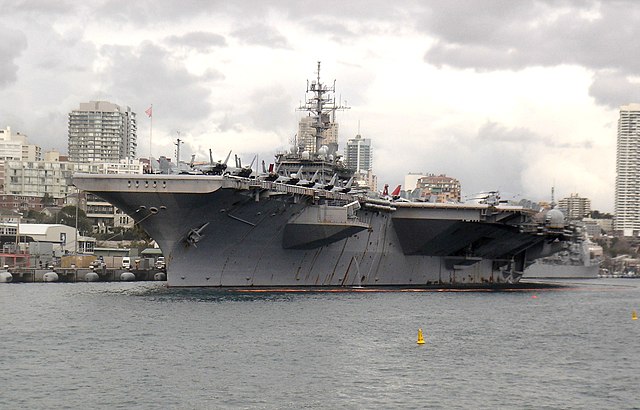
Kitty Hawk in Sydney at the end of her career
Early service
After five years of construction, since 1956, USS Kitty Hawk was commissioned on 29 April 1961 and started her shakedown cruise in the Western Atlantic frollowed bby her first long term cruiser from Naval Station Norfolk on 11 August 1961, stopping in Rio de Janeiro, where she carried the Secretary of the Brazilian Navy for a demonstration with Brazilian destroyers, rounding Cape Horn on 1 October. After a stop in Valparaíso, Chile, she arrived in Callao, Peru on 20 October, where she hosted the President. She arrived in San Diego to be visited by Admiral George W. Anderson, Chief of Naval Operations, for ASW demonstrations and Terrier missile launch by USS Topeka and her own air exercizes.
Afetr a short overhaul in San Francisco Naval Shipyard by November she joined the Seventh Fleet on 7 October 1962, relieving Midway as flagship and participating in the Philippine Republic Aviation Week Air Show, later embarking Admiral Harry D. Felt CINCPAC for another demonstration o, 3 December. She visited Hong Kong and Japan, new station at Yokosuka (2 January 1963). As flagship, CarDiv 7, she preformed exercises in Jan-Feb. 1963, followed by Operation Checkertail‘s mock airstrikes on Okinawa, Picture Window III in interceptions on Northern Japan, Red Wheel to assess the readiness of the the HUK (Hunter-Killer) Group and stippin in several Japanese ports. She was back in San Diego on 2 April 1963.
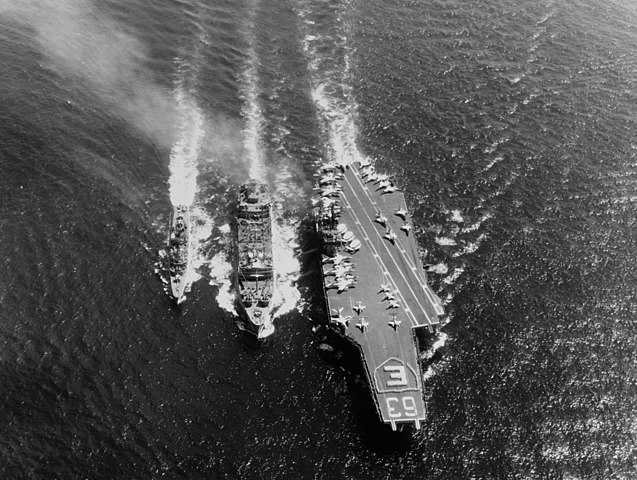
USS_Kitty_Hawk_CVA-63_and_USS_Turner_Joy_refueling_from_USS_Kawishiwi_23_April_1964
On 6 June 1963 she was visited by President John F. Kennedy and white house staff, for a task force demonstration off California. Her proncounced a famous discourse during his stay to the fleet. Later she hosted Film director John Frankenheimer for “Seven Days in May” movie. After strike exercises and tactics between the coast and Hawaii, she returned to Yokosuka, learning there President Kennedy has been short, and knocking flags half-mast when entering Sasebo (25 November) the day of funeral, and firing memorial salutes. She cruised between the South China Sea and Philippines and was back in San Diego by July 1964.
In Vietnam 1965-73

After her overhaul in Puget Sound and refresher cruise off the western seaboard Kitty Hawk was back in San Diego, then Hawaii, and the Subic Bay, Philippines, in preparation for combat operations off Vietnam. She made another overhaul at San Diego and while back in south asia hosted the 1966 Walt Disney comedy Lt. Robin Crusoe, U.S.N. She called Yokosuka in November, relieving USS Constellation as flagship RADM David C. Richardson, TF 77.
On 5 December, she arrived at Yankee Station, starting her around-the-clock operations over nort Vietnam, hosting along the way William Randolph Hearst Jr., Bob Considine, Dr. Billy Graham, Nancy Sinatra and John Steinbeck. She was back in San Diego on 19 June and maintenance at Long Beach, back to San Diego and extensive training to be back in the far east.
She later gained a Presidential Unit Citation for exceptionally meritorious and heroic service (23 December 1967-1 June 1968) taking part in the Tet Offensive, plus the Navy Unit Meritorious Commendation for exceptionally meritorious service (15 January 1969-27 August 1969) for intensive Southeast Asia support, and Northeast Asia. She suffered a fire while in port at Subic Bay which was quelled in 51 hours. On 16 January 1968 she lost a C-1A Trader on deck due to bad weather. She departed in June 1969 for San Diego and Puget Sound drydock period.
On 12 October 1972 while in the Gulf of Tonkin a race riot between 200 sailors caused some 50 sailors injured, the incident being widely publicized and followed by a Congressional inquiry of discipline. She did not took part in late operations until the war ended or ARVN troops support: From January through July 1973 indeed, she was based in San Francisco and returned in dry dock on 14 January 1973, to convert her into a multi-mission carrier (CV). This indicated she would take on also anti-submarine warfare, the first Pacific Fleet carrier so designated.
Conversion from CVA to CV-63 and fire
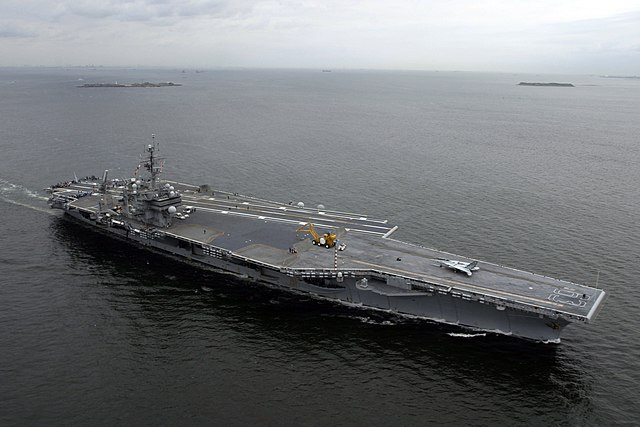
She earned ten new helicopter calibrating stations, sonar/sonobuoy readout and analysis center and operating procedures were revised while an Anti-Submarine Classification and Analysis Center (ASCAC) was added to her CIC. ASCAC depended for operations on Carrier Air Wing 11. Propulsion-wise Navy Standard Oil was swapped for Navy Distillate Fuel. Onb deck, the jet blast deflectors (JBD) were improved and enlarged, while she received better catapults to launch the large Grumman F-14 Tomcat. The first Aircraft Elevator was redesigned, with an angling out 6°. Thus was over on 28 April 1973 and she departed for post-overhaul training;
From Hunters Point NyD, to San Francisco, the carrier cruised for tests to Pearl Harbor, making R&R along the way, and proceeding to South China Sea. While underway on 11 December 1973 in her first machinery room, a flange gasket failed and JP5 jet fuel was sprayed and ignited. The fire and damage took 38 hours to master. The amount of smoke was such mostof the crew non part of the damage team was ordered on deck. For a time she listed 7 degrees portside and aircraft had to be moved starboard for balance. Six died in the inferno, plus 34 severely intoxicated by the smoke.
USS Kitty Hawk arrived in Subic Bay for damage to be properly assessed and repairs. On 10 January 1974, an investigation was ordered by RADM Donald C. Davis CG1, the blame falling soon on the six men who died in the initial fire. Conclusion on 10 January 1974, pinpointed the start to a faulty replacement of the defective gasket in the strainer cover assembly, reflecting “poor judgment and unsound maintenance practices.” However they were awarded the Navy and Marine Corps Medal for fighting the fire, a relative relief for their families.
The seventies
Kitty Hawk served extensively between the Western Pacific (RIMPAC 1973, 1975) and on 12 March 1976 was receiving a major overhault at Puget Sound Naval lasting for 12 months to better operate the F-14 and S-3A “Viking”, including modifications to the storage, ordnance handling and maintenance facilities. Work areas for airframes and repair were revised, as well as better avionics support as the S-3 was a rather electronically-complex plane. Her Terrier SAMs were replaced by sea Sparrow, with ordnance elevators and magzaine modified as well as linked electronics. She was underway for post-refit trials ahd refresher cruise in March-April 1977 and later from NAS North Island in October 1977 she made another depkoyment in the Pacific, until 15 May 1978.
In May 1979 she deployed Carrier Air Wing 15 (CVW-15) in the Pacific and took part in rescuring Vietnamese boat peoples. She also offered support following the assassination of Republic of Korea President Park Chung Hee. She was dispatched in the North Arabian Sea in support for the Iran hostage crisis, deploying CVW-15 and earning the Navy Expeditionary Medal. She also was chosedn to host her fourth movie, 1980’s The Final Countdown, playing as Nimitz, filmed entering Pearl Harbor in front of USS Arizona Memorial. Back in San Diego in February 1980 she earned the Meritorious Unit Commendation and Naval Air Force Pacific Battle Efficiency (The “E” Award), best Pacific carrier.
To the end of the cold war
In April 1981, USS Kitty Hawk left San Diego for the Western Pacific’s 13th time,. being awarded bot the Navy Expeditionary Medal and the Humanitarian Service Medal for her rescue efforts, and was back in January 1982 in Bremerton for a long overhaul, upgrade and subsequent training with Carrier Air Wing 2. In 1984 she became flagship, Battle Group Bravo, and spending the most time at “Station Gonzo”, north Arabian Sea. By March 1984 she took part in “Team Spirit” off Japan, shadowed by K-314 (Victor class). On 21 March K-314 surfaced directly in front of Kitty Hawk and was rammed in the dark. If the carrier suffered little, the Soviet submarine was bacly damaged and limped back to base. In derision a red submarine was painted on her island while she was back in San Diego.
She stopped before departing to Subic Bay for initial repairs and piece of K-314’s propellers was retrieved in her as her Soviet anechoic coating, gold for USN intel services. After repairs and 7 months extra service she was awarded another Battle Efficiency “E” Award. By July 1985 with CVW-9 she was at Battle Group Bravo. In August a press article related how she smuggled missiles and jet parts into Iran after the FBI arrested seven suspects (“Iran-Contra scandal”).
In 1986, she lost an Airman in flight operations during launch. She later left her home port for 25 years, spending 106 days on the Indian Ocean station, earning later the Navy Expeditionary Medal and the Meritorious Unit Commendation. She was in Philadelphia NyD on 3 July and entered later her main SLEP overhaul, until 2 August 1990, sieing the end of the cold war. Although she was good for 20 years of service post-cold war restruction came in. She made her second deployment between Indian Ocean and South America, taking part in Gringo-Gaucho with the Argentine Naval Aviation.
By 1st August 1992, she carried the Cruiser-Destroyer Group 5 Commander with DesRon17 staff and CVW-15 for three months in the Western Pacific by November 1992. She was later off Somalia supporting Operation Restore Hope. Back to the Persian Gulf on 27 December 1992 her air group joined the coalition offensive strikes over southern Iraq. She made another deployment from 24 June 1994 in the Western Pacific over concerns for North Korea. She started ASW operations against Han and Oscar II Class in the regio. The was even a serious standoff with PRC and PLAAF fighter too close for comfort around Kitty Hawk’s S-3 Vikings from VS-37.
In 1995, she carried a modified CVW-11 with less F-14 and more F/A-18 squadrons. Her 18th deployment started in October 1996 and lasted six-month from the Persian Gulf and Western Pacific. She toures Australia and stopped in Manama, Bahrain. She was back in San Diego in 11 April 1997 for a $110 million overhaul in Bremerton Drydock ending in March 1998. At the time, few preedicted she would still be around in the 2020s…
USS Kitty Hawk departed San Diego on 6 July 1998 as a forward-deployed CV, replacing USS Independence, with Carrier Air Wing 5 aboard and deployed at NAB Atsugi.She operated from Yokosuka. As Independence was decommissioned she became the second-oldest active warship in the US Navy (she flew the First Navy Jack). She took part in Exercise Tandem Thrust off Guam and sent her CVW-5 team in the Persian Gulf for the No-Fly Zone. Later returned aboard, the carrier visited Australia and Thailand. Next she took part in Exercises Foal Eagle and AnnualEx 11G and later Cobra Gold with Singapore and Thailand.
By fall 2000 she took part in Exercise Foal Eagle and in 2001 stopped in Singapore, and Changi Naval Base. In April she was Guam celebrating 40 years of active service before taking part in Exercise Tandem Thrust 2001 with Australia and Canada. She was often flown over by Russian warplanes in the Sea of Japan. By October 2001 she was in the North Arabian Sea for Operation Enduring Freedom and as staging base for the 160th Special Operations Aviation Regiment. She vsited Guam, Singapore and Hong Kong, and after training in the Western Pacific, trained with the Japanese Maritime Self Defense Force (AnnualEx 14G), followed by a 5-month maintenance time in 2003.
In 2003 she took part in Operations Southern Watch and Iraqi Freedom. By May 2003 she was drydocked in Yokosuka for maintenance. On 3 July 2005 she was in Sydney for a crew’s leave. She was based in Guam and by Xmas in Hong Kong. In June 2006 after her second restricted availability period she was overflown by a Russian Il-38 and by August 2006, was back in Australia, and next to Thailand and back in Yokosuka. By October 2006, during exercises she was “mocked-sunk” by a Chinese Song-class submarine which shadowed the group, surfacing just 5 mi (8.0 km) of the group on 26 October, something rare and reported as incident, and remained undetected until then.
On 11 January 2007 she was in maintenance in Yokosuka, relieved by USS Ronald Reagan. She took part off Australia to the Exercise Talisman Sabre and by September 2007 back in Yokosuka, followed by the exercise Malabar in the Bay of Bengal. She was denied entry into Hong Kong for Thanksgiving but stayed offshore during the Taiwan election on 20 March 2008, entering Hong Kong for the last time. By May 2008 she depoarted Japan, replaced by USS George Washington, but the latter experienced a fire and Kitty Hawk stayed in Hawaii, eventually taking part in RIMPAC 2008 this summer and being back in August at NAS North Island.
Separated from Carrier Air Wing 5, transferred to USS G. Washington, she awaited her fate in 2007, and Captain Todd Zecchin announced her would overseeing her decommissioning, after she left Yokosuka on 28 May 2008, her very last visit. Kitty Hawk and John F. Kennedy were suitable for conversion into museum ships, more complicated then nuclear carriers such as USS Enterprise or the Nimitz class and she was decommissioned in Wilmington, North Carolina, waiting an ecquisition. In March 2017 a Veterans Association raised $5 million in pledges while some US Navy officials during the Trump administrations wanted to have her extended in the reserve inactive fleet. But she was stricken on 20 October 2017, and the Navy announced her scrapping.
By March 2021 she was in Puget Sound dry dock for last maintenance and by October, sold for one-cent to International Shipbreaking Limited, leaving on 15 January 2022 to Brownsville, Texas, via the Straits of Magellan and arriving on 31 May 2022. As these lines are written (28/06/2022), the scrapping is ongoing and would probably last until late 2023.
 USS Constellation (CV-64)
USS Constellation (CV-64)
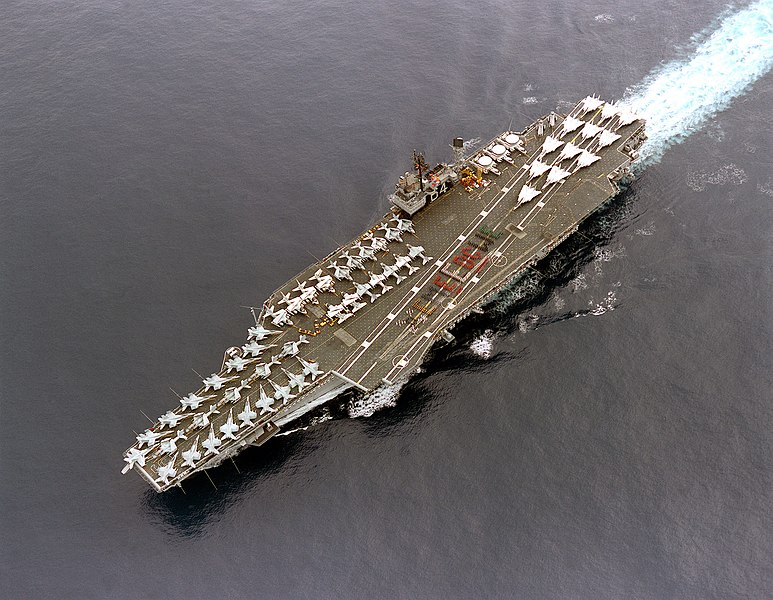
USS Constellation (CV-64) aerial Battle E
Started in 1957 and completed on 27 October 1961, USS Constellation had her initial trials period pushed back due to repairs following heavy damage due to a fire while under construction on 19 December 1960. It happened in Brooklyn Navy Yard and causes are still uncertain today, several hypothethis including vo,nuntary arson by local mobs or disgruntled workers. It started in the forklift on the hangar deck and happened when its cargo was pushed into a steel plate, knocking it over. The plate in turn broke the plug of a 500 US gallons diesel fuel tank, spilling its content and igniting when reaching the lower levels, probably by a cutting torch and consuming the wooden scaffolding.
It took 17 hours for firefighters to master the fire, but the repair cost was estimated 75 million as hundreds of plating had to be cut out and replaced, buckled by heat. Electric cabling needed replacement as well as many otbher recently fitted parts. Firefighters remarkably saved hundreds of lives that day having no causalities, but later found in the debris fifty shipyard workers corpses, burnt to a crisp in the inferno or by toxic smoke. It took seven more months to have the carrier back into completion.
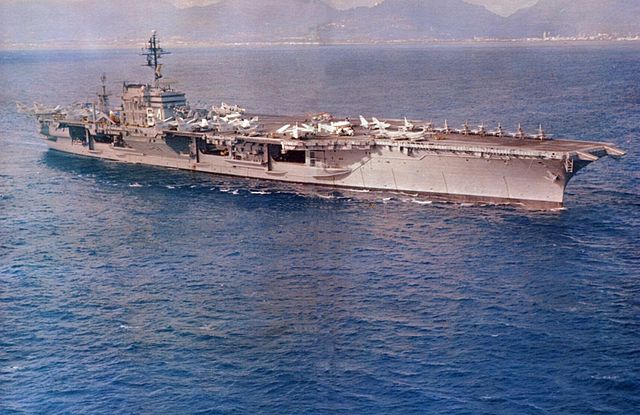
Constellation stated sea trials with Captain T. J. Walker in command but the unlucky ship experienced another fire on 7 November 1961, during tests, killing four, injuring nine sailors. After acceptance trials and post-trials fixes she departed for Norfolk and her Virginia Capes initial training, without the air group. With a few test planes she carried her first catapult launch and arrested landing until Commander George C. Watkins arrived at the head of air group (CVG) 13, bringinf to the ship the A4D-2 Skyhawks of Attack Squadron 34. “Connie” (her newly earned nickname) started her two-month shakedown cruise as usual in the Caribbean.
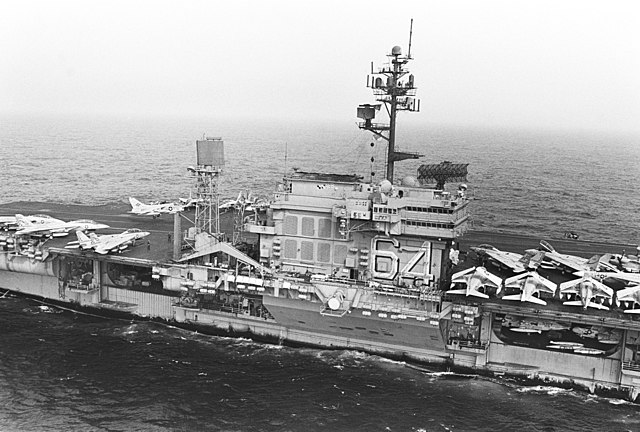
The summer of 1962, saw her sent to the Pacific Fleet, CVG-13 being sent on another affectation. She made a two-month trip around Cape Horn instead of goning via Panama, to harden the crew, before reaching San Diego and embarking CVG-5 off Mayport in Florida. By November CVG-14 joined in also and she started air operations underway to her maiden deployment to the western Pacific and the 7th fleet. She arrived back in San Diego in September 1963.
“Connie” in Vietnam
Her second Pacific TOD started on 5 May 1964, relieving her sister USS Kitty Hawk in the Gulf of Tonkin for the start of Vietnam Operations on 8 June. She embarked CVW 14 by 20 December 1963 staeting a round of reconnaissance missions over Laos in June-July. After maintenance in Subic Bay, she entered Hong Kong for the first time on 27 July, and was recalled due to the Gulf of Tonkin Incident (2 August 1964).
Two days after arrival, she launched her F-4B Phantom IIs with those of USS Ticonderoga to cover destroyers allegedly attacked by North Vietnamese MTBs (which happened bogus). On the 5th Operation Pierce Arrow, air strikes over North Vietnamese oil facility and vessels commenced. CVW-14 lost two including an A-1 Skyraider and A-4 Skyhawk, the first airmen POWs of this war. She was back in San Diego on 1 February 1965 after a nine-month deployment and both the carrier and CVW-14 were awarded a Navy Unit Commendation (NUC) under CarDiv 9 command.
After her first long (8 months) maintenance time, she departed with CVW-15 on board for Vietnam, commencing operations in May 1966, for 111 straight days on station. One F-4B from VF-161 shot down a MiG-17 on 13 July, the first CV air kill. USS Constellation was back in San Diego by December, having lost 16 aircrewmen and 15 aircraft. CVW-15 was awarded another NUC. She started her third TOD from April 1967 with a reconstituted CVW-14 and operated from Dixie Station 60 miles (97 km) off South Vietnam, hitting the Iron Triangle. She also operated from Yankee Station off North Vietnam for a total of 121 days. For all this time, F-4Bs of VF 142/VF 143 counted four more MiG kills, for 16 aircraft lost and 20 personnel (including 8 POWs) motly to SAMs and she was awarded another NUC.
“Connie” made her fourth deployment in the western Pacific and Vietnam from May 1968. She was restricted to strikes below the 20th parallel, North Vietnam after a Presidential order. On 1 November, all operations were halted. Her last plane in mission was a lone A-7 Corsair II. She was back home in January 1969 totalling 11,000 combat missions, with 20,000 tons of ordnance spent and 15 aircraft lost, 6 pilots KiA, 5 MiA and 3 POWs.
In August 1968 she returned in Vietnam for her fifth TOD with CVW-14 and for 20-day supported striked over South Vietnam and Laos, then from Defender Station in the Sea of Japan as situation deteriorated over the Korean Peninsula. On 2 October 1969 she had a grave helicopter accident, the latter crashin on deck, killing all the crew and passengers. Back to Yankee Station on 1st November one F-4J aircrew made the 100,000th arrested landing. On 28 March 1970 of Phantom II from VF-142short down a NVA MiG-21. After 128 days of operations and nine-month, loosing 7 aircraft, she went home for a long overhaul.
USS Constellation was decomm. for a nine-month drydock overhaul. The spring of 1971 saw her gaining a new air group, CVW-9 as she departed San Diego for operations over logistic targets in Laos and reconnaissance over North Vietnam. On 19 January 1972 one VF-96 F-4 downed a MiG-21 and she stayed on station dutring the North Vietnamese Easter Offensive. She conducted daily air strikes in support of SVA troops and major targets in North Vietnam. On 8 May 1972 VF-96 shot down a MiG-17 and on 10 May, three, therefore Lieutenant Randall H. “Duke” Cunningham and Lieutenant (junior grade) William P. Driscoll shared the status of first aces of the Vietnam war. Three more were short down by VF-96 and VF-92 a MiG-21. Connie was back home after 154 days off Vietnam with as much Migs down than aircraft lost, earning a Presidential Unit Citation.
The troubled seventies
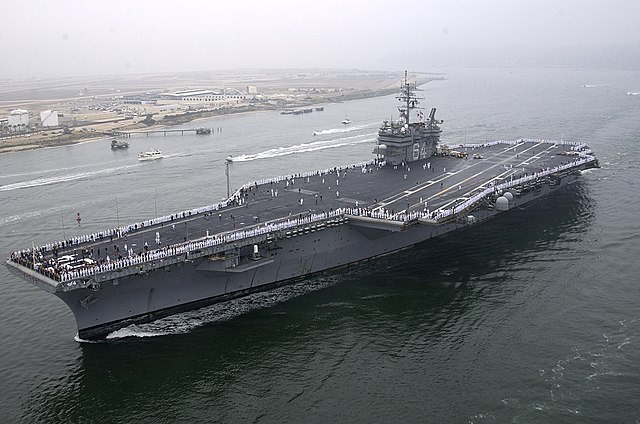
“Connie” Back in San Diego
USS Constellation was the focus of media attention as crew’s black members protested over systemic racism, leading to an aborted mutiny in late 1972. The same happaned on Kitty Hawk and other carriers at the time, and registers in general with troubles at home since the civil right and anti-war protests of the 1960s. “Connie”, back home on 1 July was prepared to return off Vietnam by early 1973 but delayed by replacement personnel and the commanding officer ordering administrative discharges for five black sailors considered as troublemakers ignited the protests. 250 more were soon concerned.
While in exercises off the California coast, the rumored 250 discharges spread into near-mutiny and a riot onboard; the result of which were filmed by television crews. Eventually discharges were carried out and the ship went back to Southeast Asia just as the Paris Peace Accords took effect (28 January). CVW-9 went on striking targets in Laos until a definitive cease-fire was pronounced on 21 February. “Connie” therefore was present fopr the whole Vietnam war and became the most praised, decorated, batte-hardened of all carriers in this war. The remainder of her deployment was to cover mine-clearing operations in North Vietnam.
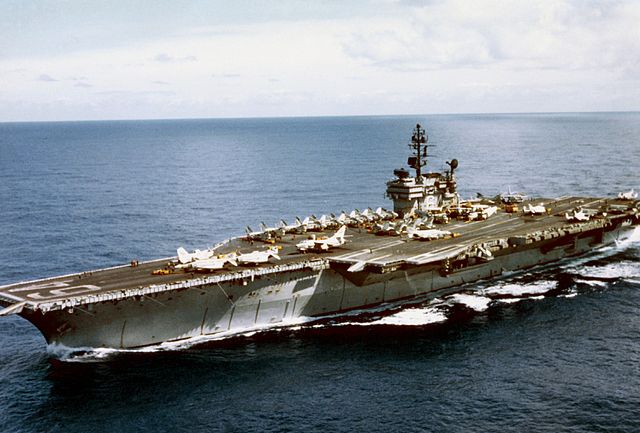
Underway in 1971-72
Back home in October 1973, with nine-month workup she made her first peacetime deployment in 10 years and in November, became the first carrier to enter the Persian Gulf since 1949. She was back on 24 December 1974. After a very long (14-month) overhaul and upgrade at Puget Sound from February 1975, redesignated “CV” on 30 June 1975 and modified like her sister for ASW operations. Now able to operate the S-3A Viking and F-14A Tomcat, she was able to take part in 1977 RIMPAC off Hawaii but she was back in the Far East until lat 1977.
USS Constellation was deployed in the Indian Ocean due to the crisis in Yemen in 1978. From February 1980 under Captain Leon Edney’s command she took part in RIMPAC exercises and took place at Gonzo station, Arabian Sea, after the Iran Hostage crisis. She departed the station on 1 May after 110 days, earning a Navy Expeditionary Medal.
Constellation’s late service 1980-90s
After her 1981 maintenance she was visited by President Ronald Reagan on 20 August 1981, declaring she was “America’s Flagship” the crew being presented a presidential flag. He also said “Let friend and foe alike know that America has the muscle to back up its words, and ships like this and men like you are that muscle.” Now under Captain Dennis M Brooks she returned to the western Pacific and Indian Ocean until May 1982.
In January 1983, she started a 13 months major Overhaul in Puget Sound, having her Terrier replaced by Sea Sparrow and CIWS, among others. She was now able also to operate the new F/A-18A Hornet? Deployed until August 1985 with CVW-14 she sailed with USS Jacksonville, USS Worden, USS Camden, USS Crommelin and USS Fletcher from the port of Mombasa, Kenya, gaining there her motto “Go Ahead Make My Day” painted on the ship’s island, quoting President Reagan after void terrorist threats during the 1985 TWA Flight 847 crisis. She later earned the Meritorious Unit Citation and Navy’s Environmental Protection Award.
The 1987 deployment earned her also the Pacific Fleet Battle Efficiency Award (“Big E”) for her 18-month 1986 continuous stay. By April-October 1987 she took part in Operation Earnest Willescrting re-flagged Kuwaiti tankers in the Persian Gulf. She also earned the Armed Forces Expeditionary Medal.
The “Unlucky Connie” 1988 explosion
On 2 August 1988 she slipped her moorings in a routine carrier qualification off southern California, while a JP-5 fuel leak in the uptakes reached her main machinery room. The resulting exploision torne down uptakes and spread quickly. Bith the fuel Oil Supervisor and Oil Lab were blamed for failing to do the transfer as required while a Boiler Technician triggered the halon fire suppression system. Due to the 30 minutes wait after it, the still hot space reignited the fire resultng in further explosions, until General Quarters was given. Volunteers managed to extinguish the fires but despite damage control frantic efforts if the main fires were extinguished around 21:00 they soon reflashed leading to a full night of battle.
An over-temperature alarm sounded in the Mt. 23 CIWS 20 mm ammunition magazine at some point (port side of the island), which urged offloading the magazine due to unsufficient pump pressure for flooding it. Despite all the collateral fires, amazingly there were no fatalities, but smoke inhalation injuties and the damage was immense. She entered North Island on 3 August for investigation which led to the inspection and repair of all JP-5 pipes on all USN CVs afterwards. This was a failure of previous maintenance. Total of JP-5 pumped into the uptakes was approximately 20,000 gallons at the time.
SLEP and later years
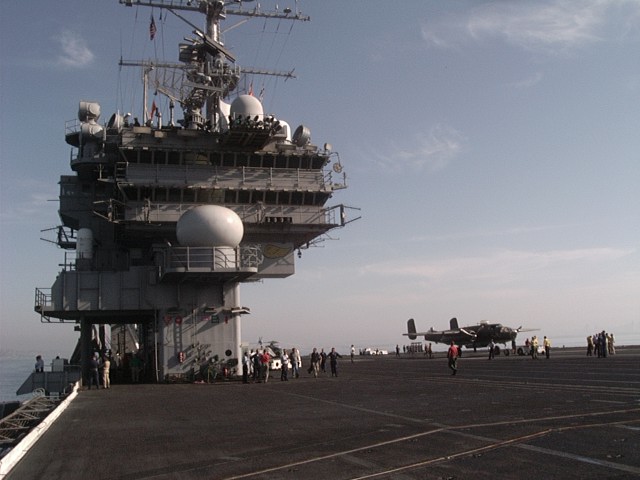
A B25 Mitchell on deck during the shooting of the Pearl Harbor movie
Quick repairs assisted by civilian contractors had Connie ready for another TOD on schedule with CVW-14, starting on 1 December 1988 in the Indian Ocean. She also had a screw repaired at Subic Bay. She later lost a Prowler at sea. Her West-Pac TOD ended in San Diego on 1 June 1989. She embarked CVW-9 by February 1990 for exercises on the East Coast and Gringo-Gaucho exercize. Next she had her SLEP in Philadelphia NyD, completed in March 1993, including among other the replacement of her gigantic steam turbines, of a standard no longer seen for decades in the USN.
After her post-SLEP shakedown with CVW-17 aboard at Mayport, Florida, she received instead CVW-2 and departed in late May for exercises off South America underway to San Deigo where she arrived on 22 July 1993. By May–June 1994 she took part in RIMPAC and on 10 November departed San Diego for exercises off Okinawa and off Korea after intel revealed a nuclear weapons program. On 11 January 1995 she led a battle group in the Persian Gulf for Operation Southern Watch the south iraq no-fly zone after after six-month was back in San Diego. From 1st October 1995, she was escorted by CruDes Gp 1, from 1 April to 1 October 1997 in the Persian Gulf (Operation Southern Watch) with the Fifth Fleet. In 10 weeks she made 4,400 sorties.
Her 1999 deployment saw her off the Korean Peninsula after gunfire between North and South Korean vessels. From August she was in the Persian Gulf for ten weeks and 5,000 sorties, including air strikes against two Iraqi radar stations and a duel wirh Iraqi jet using the Phoenix missile on 14 September. She was back home on 17 December earning a second “Big E” (Best Pacific carrier). She started her 20th deployment from 16 March 2001, in the Persian Gulf (from 30 April, for Operation OSW), under command of Captain John W. Miller, her last. She sailed to Pearl Harbor in September for the classic “Tiger Cruise” to San Diego.
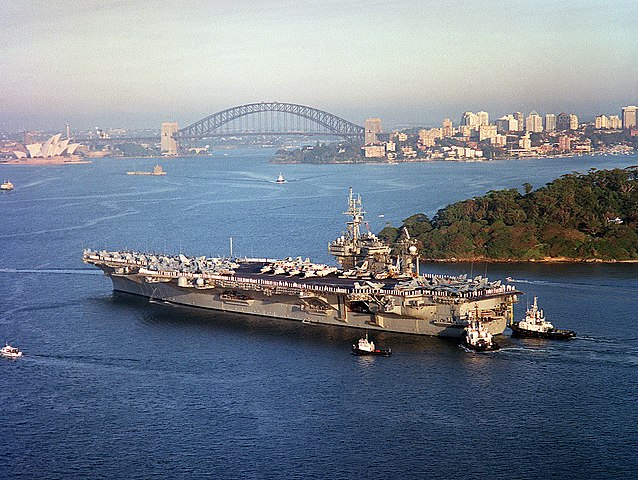
USS Constallation in Australia, 2001
On 11 September 2001, halfway there, the crew learned about the terrorist attacks on New York and the Pentagon. She arrived in San Diego on 14 September for her 40th birthday a,d after maintenance, she made her final deployment as part of the “Global War on Terrorism” from 2 November 2002 with CruDes Gp 1 (RADM Barry M. Costello) and Operation Enduring Freedom. On 17 December she entered the Persian Gulf and by 19 March 2003 started cover missions for Operation Iraqi Freedom. Designated night carrier she launched 1,500 night sorties with CVW-2 aircraft, dropping some 770,000 kg of ordnance. One aircraft was lost due to malfunction was all she reported.
She departed on 17 April for San Diego and from June receiced aboard VS-38 equipped with S-3B Viking; one of which made the last carrier’s arrested landing in her 21st deployment. With 41 years of service, a record, she was decommissioned at NAS North Island, San Diego, on 7 August 2003. Towed in September 2003 to the Naval Inactive Ship Maintenance Facility (“ghost fleet”) in Bremerton and stricken on December 2003 due to maintenance costs. Reserve Category X ended in February 2008 when it was announced her dismantling which started on 26 January 2012, alonsgide Forrestal and Independence.
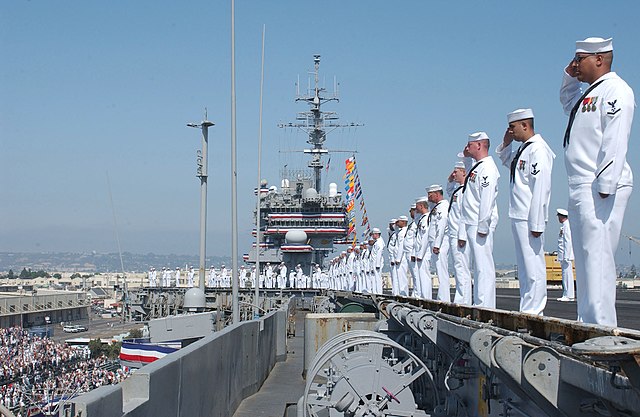
Decommission ceremony
She was scrapped at Brownsville, Texas from 2015, towed for this around Cape Horn, starting on 16 January and ending on 10 May 2017.
 USS America (CV-66)
USS America (CV-66)
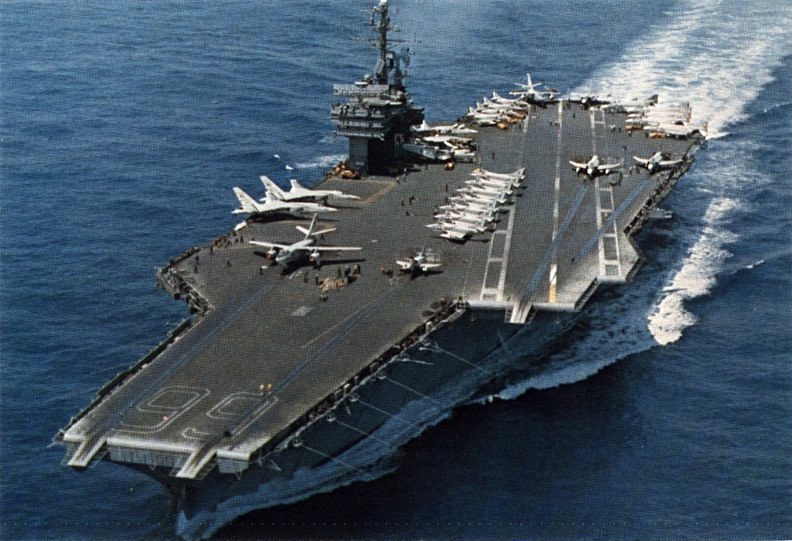
USS America underway 1967
USS America was commissioned at Norfolk NYD on 23 January 1965 under command of Captain Lawrence Heyworth Jr. Fitting out lasted until 15 March 1965, after which she trained in Hampton Roads and off the Virginia Capes, departinf on 25 March and making her first catapult launch on 5 April 1965 with her CEO piloting a Douglas A-4C Skyhawk. She made her shakedown cruise in the Caribbean, entering Guantánamo Bay on 23 June 1965.
Mediterranean service
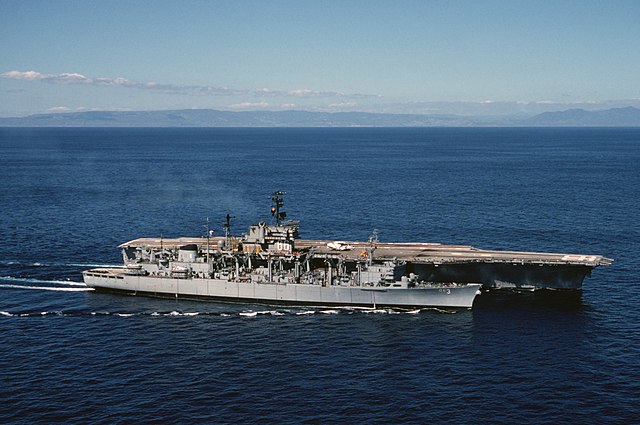
CV-66 underway with USS Seattle in 1976
After a stop at Norfolk for post-shakedown fixes in ealy june, remaining until 21 August she returned for extra training off the Virginia Capes and Bermuda and back in Norfolk on 9 September. The 25th saw her flagship, RADM J. O. Cobb, CarDiv 2. She started her first tour of duty (TOD) in the Mediterranean a deployment lasting only a year. She departed late in 1965 and spend the new year’s day in Livorno, Italy. She visited Cannes, Genoa, Toulon, Athens, Istanbul, Beirut, Valletta, Taranto, Palma, and Pollensa Bay also taking part in the NATO exercize “Fairgame IV” until back at Norfolk on 10 July, operating there until 19 September to continue training in the Carribean, weathering Hurricane Inez, her crew helming restoring the devastated Guantanamo base.
In October she saw her first A-7 Corsair II conducting flight qualifications, off the Virginia Capes. She also tested an atomatic landing “no hands” system with F-4 Phantom, F-8 Crusader and A-4 Skyhawks. On 16 October two of her Phantoms collided in midair. On 3 September 1965 she was back for her second Med TOD, underway to Taranto, when loosing a plane as a catapult malfunctioned, which destroyed another. In all she would loose five planes.
Until 15 December, when back to Norfolk she took part in “LANTFLEX 66”. She started her third Med TOD on 10 January 1967, relieving USS Independence at Pollensa Bay on 22 January. She qualified also underway her SH-3A Viking crews, and practiced missile shoots in mid-Atlantic, day and night air operations. Off Gibraltar, she was shadowed by a Tu-95 “Bear” (18 January) intercepted by two scrambled F-4B.
On 4 February underway to Athens she took part in Italian control and reporting centers and met with the Marine Militare simulating a fast patrol boats attack. By early March she operated with Task Group 60.1, Task Force 60, for “Poker Hand IV” with HMS Hermes, making cross deckings and combined or opposed air defence exercises.
On 1 April she took part in “Dawn Clear” with TG 60.1, send and air raid against against Greek and Turkish “targets.” follopwing by extra training in the Ionian Sea. She stayed in Valletta and departed Malta back to the Ionian Sea, notably conducting an open sea missile exercise with USS Josephus Daniels and Harry E. Yarnell. With the civil war in Greece after the coup, the need to protect American citizens arose, including evacuation so the Sixth Fleet was constituted in a special operations task force under RADM Dick H. Guinn, TF65, USS America acting as flagship.
She stand by for evacuation, but as the coup was not violent security was not a problem and on 29 April, RADM Lawrence R. Geis relieved RADM Guinn as Commander CarDiv 4/TF 60, but also the commander of TF 65 and TF 502 (NATO) mobilized. USS America sailed to Taranto in May for rest, open to 1,675 visitors. With TG 60.1 sge departed Taranto on 8 May to train on the Ionian and Tyrrhenian Seas and stopped in Livorno.
Middle east crisis
On 25 May 1967 while off Crete USS America aproached the coast of Spain, through the Malta Channel joining TG 60.2 (Saratoga and destroyers), RADMl Geis called in 48h when Egypt moved troops into the Gaza Strip, making the UN Peacekeeping Force withdrawn. As Israel also mobilized, the United Arab Republic went their fleet to close the Gulf of Aqaba to Israeli shipping after normal training operations and replenishment operations she stand on duty until 5 June, to receive newspapers and TV crews from around the globe on board. A Soviet destroyer already started to shadow the fleet on 2 June. On 7 June, VADM William I. Martin, 6th Fleet warned Soviet ship for their agressive behaviour.
The Six Day War saw USS America, escorted by USS Lloyd Thomas keeping sonar contacts with possible soviet submarines in the area, although destroyers took their distances. USS Sampson investigated the contac and starting tracking it while the carrier launched all her ASW helicopters Sea King of HS 9. The contact was confirmed by Lockheed SP-2H Neptune of VP 7, coordinating the fleet after a positive MAD contact, an even reported by newsmedias.
A-4C Skyhawk from VA-64 with Bullpup missiles were made ready after USS Liberty was attacked by Israeli forces, a technical research ship 15 mi (24 km) north of El Arish, international waters. She was heklping communications for the evacuation of American dependents in the area. The DoD ordered to scramble F-4B Phantom and more were prepared. Two A-4 Skyhawks launched and all convered to Liberty’s position while Tel Avir reported this to be an error. It costed nevertheless 34 men and 173 wounded. Destroyers arrived at 06:00 on 9 June to assist.
Meanwhile as the Six-Day War went, Arab countries decounced the 6th Fleet as providing direct air cover for Israeli ground forces, which was denied in presse conference, still aboard. Appeals for a cease-fire came and tension relaxed. Meanwhile Two squadrons of CVW-6 participated in the 27th Paris Air Show. After corssing the Dardanelles on 21 June to Istanbul RADM Geis made a state visit. About 600 students, 1,500 spectators and sympathizers made an anti-American protest march and crew’s visit was was cancelled. She departed on 26 June and returned in the Aegean Sea.
She latter stopped in Thessaloniki for the Fourth of July celebrations with the Prefect ad Mayor of Thessaloniki and American Consul, officers. On the 8th July, RADM Daniel V. Gallery USN (Ret.) arrived on board, visiting the 6th Fleet forhis later articles and books. The carrier was also in Athens and steamed to Valletta, the in August the Bay of Naples, Genoa, Valencia, Pollensa Bay, relieving USS Franklin D. Roosevelt and departed for Norfolk in September
On 6–8 January 1967, she trained off the Virginia Capes and cruised in the Caribbean for the naval technical proficiency inspection (NTPI) refresher training and doing more carrier qualifications. She prepared for WestPac and took par tin the AFWR in February with Carrier Air Wing 6, testing simulated PT boat attacks. After a stay in Norfolk she departed in March for AFWR training and “Rugby Match” exercize. She conducted another off Puerto Rico, a SAREX, photographic reconnaissance sorties, also simulating conditions in Gulf of Tonkin and firing two Terrier missiles.
With CarDiv 2 as flagship, TG 26.1 she participated in more exercises as part of the “Blue” attack Force, for drills of close air support, photo reconnaissance and combat air patrol for TF 22 off the island of Vieques. CVW-6 trained also for aerial mining mission and amphibious cover.
CV-66 in Vietnam
On 10 April 1968, USS America sailed for “Yankee Station” with CVW-6, with major training exercise underway off Rio de Janeiro and via the Good Hope. She past Madagascar and arrived in Subic Bay to gain her station via the South China Sea and after the 26 May “Newboy” carrier qualifications exercise, started operations on 31 May. She stayed 112 days on “Yankee Station”, destroying many objectives. On 10 July 1968, an VF-33 F-4J Phantom downed a MiG-21 ‘Fishbed’ northwest of Vinh over North Vietnam, the first carrier MiG kill. For its strikes, CVW-6, was later awarded the Navy Unit Commendation.
In between she visited Hong Kong and Yokosuka and added to her regular strike group, VAH-10 and VA-130 for EW taking part in “Magic Carpet”. She later went to Australia, New Zealand on her way back to Brazil and reaching Norfolk, making the usual ceremony when crossing the Equator underway. In January 1969 she headed for Jacksonville for carrier qualifications, returned to Norfolk for an nine-month overhaul, post-repair trials and refresher cruise off the Virginia Capes until November 1969, also testing the U-2R reconnaissance plane.
On 5 January 1970 she departed Norfolk for her training cruise in the Carribean and in February took part in Operation “SPRINGBOARD 70” until back in Norfolk in March-Apeil and her second Vietnam deployment with CVW-9 on board. Again she went by to Rio de Janeiro, rounded the Cape and crossed the Indian Ocean into the Pacific for a call port of Subic Bay. In late May she was in the Gulf of Tonkin, Cmdr. Fred M. Backman, commanding VA-165 from a Grumman A-6C Intruder initiating strike sorties with the new A-7E Corsair II. She spent 100 days on “Yankee Station”. On 20 August back in Manila for replsnishment and rest, VADM Frederic A. Bardshar (7th Fleet) hosted President Ferdinand E. Marcos on board.
On 17 September, she carried out her fourth frontline station period before heading for the coast of Korea and Sea of Japan via the Tsushima Straits and after a stay, existed via the Tsugaru Strait, engaging CVW-9 in exercises “Blue Sky” with ROKAF and “Commando Tiger”, “Autumn Flower” with the JASDF an 5th US Air Force. She was back in Subic in November. In total she flew 10,600 sorties and 7,615 combat and support missions, spending 11,190 tons of ordnance without a single combat loss and one landing accident with no fatalities.
Back in the Med
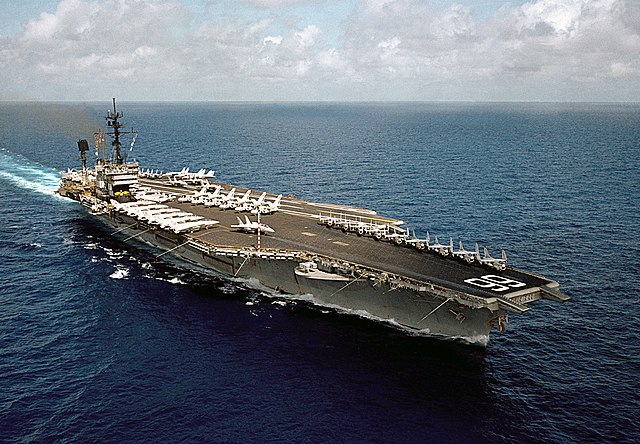
CV-66 underway in the Indian Ocean
The crew rested in Australia where she hosted the ambassador and his wife to Sydney, speneding a Thanksgivings twice while crossed the International Date Line. She was back via the Cape Horn on 5 December 1970, stopping at Rio for refuelling, and Norfolk on the 21, remaining there until 22 January 1971 and a 3 month overhaul. After which the usual refresher off the Virginia Capes, Puerto Rican waters training with HMS Ark Royal, HMS Cleopatra, and HMS Bacchante followed. She prepared in Hampton Roads by July for another Mediterranean TOD. On 16 July she was at NAS Rota in Spain to relieve USS Franklin D. Roosevelt, then Naples for three major exercises.
While underway to Palma, Majorca she took part in “PHIBLEX 2–71” (mock amphibious landing in Sicily) and in August to “National Week X” before heading for Corfu, Greece and Athens for eastern Mediterranean exercises, also stopping at Rhodes and taking part in the Aegean Sea’s Operation “Deep Furrow 71” with CVW-8. After a stop at Thessaloniki she took part in “National Week XI”, central Mediterranean and later with British, Dutch, Italian, and French forces for “Ile D’Or” until late November, stopping at Cannes and Barcelona before reaching Rota in December for upkeep and be relieved by her near-sister USS John F. Kennedy.
Last Vietnam Deployment
Back in Norfolk on 16 December, a two-month overhaul, sea trials and training, she took part in exercise “Exotic Dancer V.”. By June 1972, she carried Admiral Elmo R. Zumwalt, and escorted by USS Davis and Dewey, plus the fleet oiler Waccamaw she was back in southeast Asia via Good Hope in June, joining the 7th Fleet to relieve USS Coral Sea on station, for operations interrupted by repairs after an accident in Subic Bay delayed due to a natural disaster, and back on station on 9 August. To note her air group bombed and destroyed the very important Thanh Hoa Bridge on 6 October. After a new upkeep at Subic Bay, she was in Singapore, and returned to “Yankee Station.”
He luck ran out when a grave fire broke out onboard on 19 November 1972 in N°2 catapult space, but damage control parties mastered the damage. She remained operational on the line for 43 days, and after another call in Subic Bay by December, repairs, she was back to “Yankee Station”, learning at Xmas of the Paris agreements. She would receive five battle stars for her Vietnam service. Her crew spend the newy years’s ever in Hong Kong and she departed on 4 January 1973 for Subic Bay and back to “Yankee Station” to resume operations for two weeks until peace was secured so on 28 January 1973, ceasfire was announced while she returned in “Yankee Station” a last time until back in Subic and to the US from 20 February, calling Mayport Florida to land CVW-8 and calling Norfolk on 24 March, followed by a 30 days stand down and yard maintenance in May-August.
Post-Vietnam service
USS America trained in October and celebrated her 100,000th landing on 29 August, earning her nickname “Miss America”. On 29 October, she headed for Jacksonville to make carrier qualifications, assisting in November the crippled sailing schooner Harry W. Adams with her Helicopters. She later went to Ft. Lauderdale, Florida in November for various drills, and back to Norfolk. By January 1974 she was back for another Med TOD, calling Rota, as flagship, RADM Frederick C. Turner, TF 60. She was present in several exercises in the western Mediterranean visiting underway Toulon, Barcelona and Valencia in an late February taking part in “National Week XVI” off Crete, stopping in Athens. In March this was “PHIBLEX 9–74”, resumed in early April returning in Athens.
Next she took part in “Dawn Patrol”, a seven nations exercize, and after another stray in Athens in May she was in Istanbul, back to Athens for “Shahbaz”, and calling Rhodes in June and later “Flaming Lance” off Sardinia. Back to Athens she trained off Souda Bay and “Nimbus Star”i n the Suez Canal, then back to Corfu, and Palma, Majorca, then Rota on 15 July. With the crisis in Cyprus, she was mobilized until relieved by USS Independence, and reached Norfolk on 3 August. Next she took part in “Northern Merger” in September with HMS Ark Royal again, closely watched by Soviet surface units, “Bear” and “Badger” bombers, duly intercepted.
She sailed to Portsmouth (29 September) and back to Norfolk on 12 October and an overhaul from November 1974 to September 1975 followed by sea trials and additional training off the Virginia Capes, then Cuban waters, launching her helicopter to locate and save the crew of the stranded motorized sailboat Ruggentino. Back in Norfolk on 16 December, she was back at sea on January 1976 and by March took parft in “Safe Pass ’76” with four other navies. She made another Med TOD from 15 April 1976 with CVW-6 and CarGru 4 commander RADM James B. Linder onboard.
Lebanon crisis
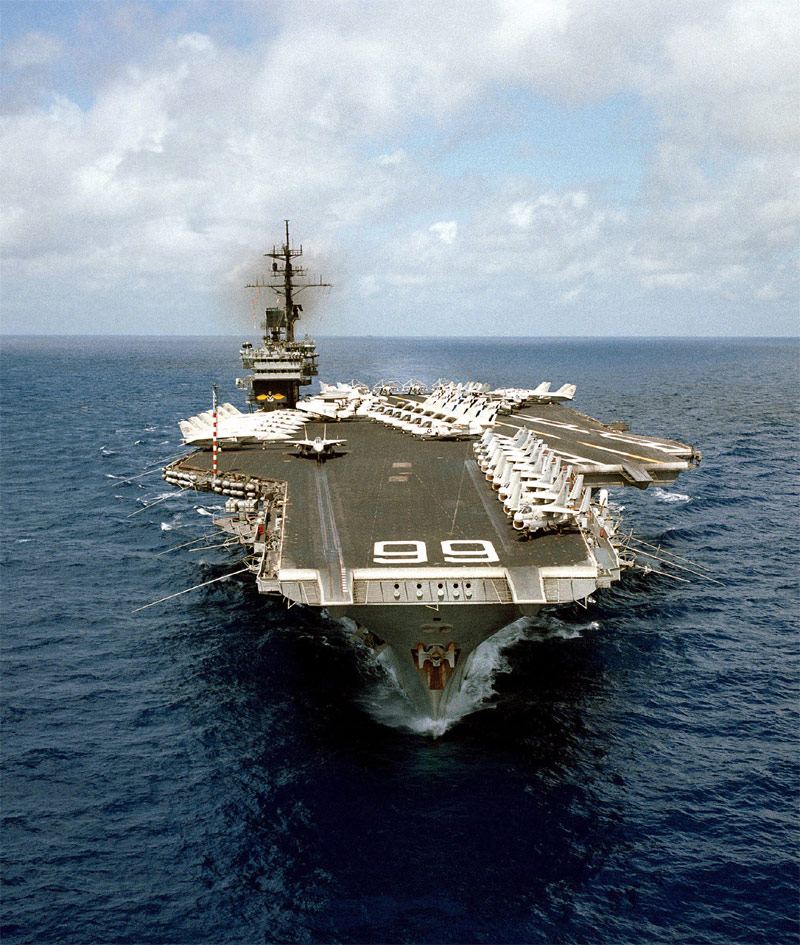
USS America in 1983
From Rota she took part in NATO exercise “Open Gate” and gained the eastern Mediterranean for Operation “Fluid Drive”, evacuating US Citizens from Lebanon. For three months she remaine din high alert for the longest stay since the Yom Kippur War. After calling Rhodes in May, Taranto, she learned underway of the assassination of US ambassador Francis E. Meloy while visiting Lebanese President Elias Sarkis on 16 June 1976. She assisted the LST Spiegel Grove evacuating personal from the beach to safety. She celebrated the bicentennial Independence Day at Bari in Italy. In July she conducted a missile exercise north of Crete while still part of “Fluid Drive”, returning on 27 July. In August, after Naples for two weeks she was back in August for “National Week XXI” and reached Palma for “Poop Deck 76” with the Armada and USAF units.
Next, after topping in Barcelona and Málaga, she took part in “Display Determination” again with HMS Ark Royal but also units from Italy, Greece, Portugal, and Turkey with the goal of practicing convoy escort duties with close air support for amphibious operations. Back to Rota, she was relieved by USS Franklin D. Roosevelt before reaching Norfolk in late October 1976. Her maintenance lasted until February and in the spring from Mayport, she took part in May’s “Solid Shield 77”. She later trained with TG 20.4 in the Caribbean and returned to the Mediterranean on 29 September with CVW-6 aboard.
From Rota in October she crossed the Tyrrhenian Sea, stopped in Brindisi, and reached the Ionian Sea on 7 November then Crete, the Kithira Island, and back to the Adriatic, Dubrovnik, Trieste, and back to Souda Bay, then Palma where she spent Christmas. Next she was in Ligurian Sea to stop in Genoa on 30 December, stying there until 8 January 1978 and ASW exercises in the Tyrrhenian Sea, followed by Sicily and back to the Tyrrhenian Sea and Catania, “National Week” on 5 February and exercises in March until back to Norfolk on 25 April. After resplenishment and carrier qualifications off the Virginia Capes she entered the Naval Shipyard for upkeep followed by exercises and more carrier qualifications in October. A Lockheed S-3 Viking missed ner landing and was lost.
1980s service
After traning off Guantánamo Bay, Ft. Lauderdale, Norfolk and Virginia Capes training, she miltiplied drills in the Caribbean until March and “BEAREX” exercise with a Lockheed P-3 Orion from Bermuda, simulating a Russian “Bear” though soon A-7 and Grumman F-14 Tomcat scrambled to intercept real “Bear D” planes on their way to Cuba. She was in Rota on 24 March, relieving USS Saratoga visiting many ports and training in the Adriatic, visiting Split and Venice, Trieste, later Alexandria and back in Souda Bay. She headed then west to Palma and Barcelona, visting also Marseille and Genoa underway to Rota and starting her crossing home in September 1979.
She took part in several multilateral exercises in the Mediterranean like “National Week XXVII”, in the the Gulf of Sirte as a show off force for Libya. Her battle group was maintained in high alert, fearing incursions on the claimed waters. CVW-11 maintained fighter cover and the exercise went on unhindered. Back to Rota in September 1979 she was relieved by USS Nimitz and she was back in Norfolk. She was in Mayport for operations off the coast of Florida and later Gulf of Mexico with carrier qualifications, later notably the new McDonnell-Douglas F/A-18 Hornet. Back in drydock on 6 November 1979, until 23 September 1980 she started post-refit trials and tested her new “Sea Sparrow” missiles and Phalanx CIWS.
She stayed in these waters until January 1981 operating also the Grumman C-1A “Trader” with onboard the first USN black female pilot, and carrier qualifications for CVW-11. Following more qualificationss and training off the Virginia Capes and Caribbean she was reassigned to the Indian Ocean for NATO exercise “Daily Double” in the Mediterranean, followed by a stay at Port Said. She transited the Canal on 5 May as Lebanon’s situation degraded, prompting her to stay. She eventually arrived at “Gonzo” Station for a stay until 3 June, visited Singapore and back to “Gonzo Station” for 35 days. After her second northern Arabian Sea stay in 4 August she headed for Australian waters and “Weapons Week” exercise off Diego Garcia.
Departing Diego Garcia on 15 August she reached Gage Roads at Fremantle in Western Australia and was back to “Gonzo Station” for 34 days. However it was interrupted by a fire on 23 September, starting in a steam trunk line but Capt. James F. Dorsey, Jr. ordered general quarters and the control teams did their job well. No casualties ansd limited damage. Sghe was relieved on station by USS Coral Sea on 16 October and via the Bab el Mandeb Strait, was on high alert due to the People’s Democratic Republic of Yemen delcaring their hostility to the US. On 21 October 1981 after the assassination of President Anwar Sadat passage was granted through the Suez Canal, escorted by the Egyptian Navy. She reached Palma on 25 October and after drills with the Armada, she was back in Norfolk on 12 November.
America in dry dock at Norfolk Naval Shipyard, 1982.
After a short ovehaul until 20 April 1982 and carribean training she took part in “United Effort” and “Northern Wedding 82”, the latter off Scotland? She was back in the Med on 26 September, for exercise “Display Determination” and bacl to Mayport and Norfolk and more training in 1983 with CVW-1, reached Palma and headed for the Lebanese coast, relieving USS Nimitz on station (2 January) staying there 18 days whiled calling Piraeus with USS Dale and Savannah. Next she was in Port Said and transited the canal on 31 January, for the Red Sea. USS America took part in “Beacon Flash 83” and a “Weapons Week” off Diego Garcia. She visited Colombo on 7 March and back in the Indian Ocean took part in “Beacon Flash 83-4”, visiting Masirah Island in Oman.
She took part in “Ocean Venture” on 24 April 1984 and returned to the Mediterranean. After Málaga on 21 May, she arrived at Port Said on 3 Junenadn transited to join the 7th Fleet on 8 June and relieving USS Kitty Hawk. On 10 July while in training in the Indian Ocean she lost a EA-6B Prowler (VAQ-135 Black Ravens) due to a catapult failure later attributed to faulty maintenance. She later back in Naples, visited Monaco and took part in “Display Determination”. On Augusta Bay on 27 October she was relieved by USS Dwight D. Eisenhower.
After carrier qualifications in the Virginia Capes she was in overhaul and in May-June made her refresher training. In August she took part in “Ocean Safari” for six-weeks up to Norwegian waters. Nothing much happened in 1985.
Libyan Crisis (1986-87)
In 1986, tensions in the Mediterranean mobilized the 6th Fleet as in January President Ronald Reagan ordered all U.S. citizens out of Libya, sending a second carrier battle group while brefieing with the general staff for possible operations on Libya. “Attain Document” took place on 24-31 January 1986 and 10-15 February while USS America operated CVW-1, participating in March and patrolling the Gulf of Sidra. On 23-24 March, operation started south of the “Line”, defined by Khadaffi. On the shore, two SA-5 “Gammon” SAMs were launched at 07:52 and reached USS America’s F-14A Tomcats, but missed; Later additional SAMs were fired as well asn attack by a Libyan Combattante II G-type FAC from Misratah, approaching from USS Ticonderoga.
Two USS America’s A-6E Intruders (VA 34) fired their AGM-84 Harpoons and sank her. It was the first use of the Harpoon in combat. A-7 Corsairs from Saratoga’s later launched AGM-88 HARMs on various radar stations and SAM sites. Next, A Nanuchka-type FAC arrived in the Gulf of Sidra was was damaged by VA-34 and VA-85 planes with Rockeye cluster bombs. She limped back to Benghazi. On 25 March, another Nanuchka-II arrived and was attackzed by Intruders from VA-85 and USS Coral Sea’s VA-55 with Rockeyes and a Harpoon. A second Nanuchka-II later was also damage, all returning to Benghazi. “Attain Document III” stopped on 27 March. CV-66 steamed for Augusta Bay in Sicily, relieving USS Saratoga on station and visiting Livorno in April 1986.
Retaliation came with the TWA bombing of 5 April 1986 and an attack on La Belle Discothèque in West Berlin. Later President Reagan directed attacks on terrorist-related targets, which was “Operation El Dorado Canyon”. It started on 14 April 1986 with tanker aircraft from American RAF bases in England for the F-111F Aardvark and EF-111A Raven, some from the Iberian Peninsula and through Gibraltar, also flying over France, Spain, and Portugal. USS America launched six A-6 Intruder (VA-34), six A-7E Corsair IIs and USS Coral Sea eight A-6Es, six F/A-18 Hornets, others providing CAP. It was as later stated
“a spectacular feat of mission planning and execution”. All the targets were slmulaneously attacked on 19:00 with Shrike and HARM missiles (SAM sites at Benghazi and Tripoli) and Mk. 82 bombs on the Benghazi military barracks. Four crated MiGs being destroyed there among other.
CV-66 late career: 1988-2000
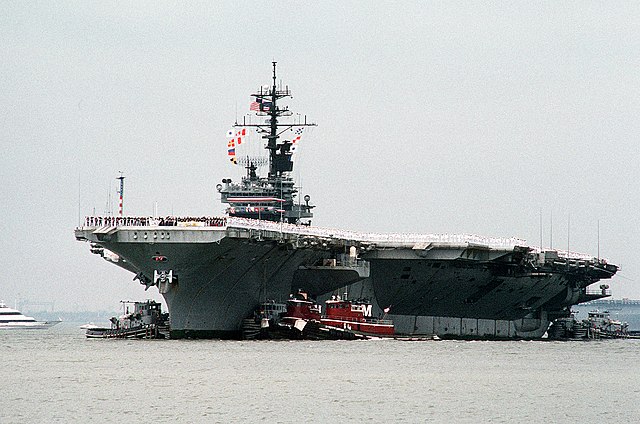
USS America returns from Operation Desert Storm
USS America was in Naples from 28 April tp 4 May and took part in “Distant Hammer” with the Italian and Turkish Air Forces. After a stop at Nice and Monaco she operated with USS Coral Sea and Enterprise for “poopdeck” with the Armada and USAF from Spain. Next, “Tridente” and “National Week” were followed by a visit of Catania and a stay in Benidorm, Spain. She was relieved by USS John F. Kennedy in Rota by late August to be back in Norfolk for an overhaul until February 1988.
Taking part in Operation North Star in March in the vestfjord and the Kola peninsula, she was shadowed by a Slava-class cruiser. After a stop in Norfolk by May she departed for her 16th deployment, to the Mediterranean and Indian Ocean. On 13 May 1989 she had a JP-5 pumproom fire and explosion killing two but quickly mastered after 7 hours. On 11 August she teamed with USS Coral Sea for the eastern Mediterranean as a show of force (after the supected murder of Marine Corps LtCol William R. Higgins with other hostages). She was back home on 10 November 1989.
She took part in the evacuation of the American Embassy in Lebanon in 1989 and until November and later took part in Operations Desert Shield and Desert Storm in 1990 and 1991 as well as Operation Deny Flight. For Operation Desert Shield she had Captain J. J. Mazach in command. She tested for the first time in combat her new NTCSA system, CTAPS and an Advanced Tracking Prototype, for the first time in a single package, coupled with NTDS, C4I with digital data links with fleet, the most advanced in the world at that time. She also had tactical B57 and B61 nuclear weapons aboard.
America, Saratoga and John F. Kennedy battle groups formed Battle Force Red Sea for this operatio, started at 02:00 hours on 17 January. She deployed CVW-1, as CAP and later for air strikes, north of Baghdad. Later bridges, mobile Scud sites, oil production facilities and Republican Guard units were hiy. On 14 February, she was assigned to Battle Force Zulu with USS Midway, Ranger and Theodore Roosevelt for strikes over the Kuwait Theater of Operations and eastern Iraq.
On 20 February, VS-32 S-3 squadron destroyed an Iraqi gunboat. On 23 February, a Silkworm missile battery, which fired at USS Missouri, was destroyed. The following day, close air support for coalition forces started on a frantic pace. Some hit the infamous “highway of death” adn Kuwait was liberated after 100h of the assault, her own air group claiming 387 armored vehicles and tanks. She depoarted on 4 March after 3,008 combat sorties and 2,000 tons of ordnance dropped with no loss. She was back in Norfolk on 18 April, earning her 3rd Navy Unit Commendation.
After taking part in New York City’s “Welcome Home”, Fleet Week festivities, she took part in “North Star” in the north atlantic and to Norway for eight weeks. After another six-month deployment she was back in the Persian Gulf, visited on arrival by the Kuwaiti leadership and US Ambassador. After exercizes in the Indian Ocean and Red Sea, Mediterranean she returned to Norfolk in June 1992. With her Joint Task Group she departed in August 1993 to relieve Theodore Roosevelt engaged in Operation Deny Flight.
For several weeks she supported the UN flight exlcusion zone over Bosnia and Herzegovina. Next she crossed Suez on 29 October 1993, relieving USS Abraham Lincoln in the Indian Ocean for their humanitarian efforts in Somalia, covering 2,500 mi (4,000 km) in a week. CVW-1 also flew over southern Iraq for Operation Southern Watch. On 12 December she crossed Suez and headed to Norfolk. On 12 September 1994 USS Dwight D. Eisenhower and America were deployed off Haiti with many Army helicopters on board in support of President Clinton’s policy to restore democracy. It was a first for such action.
On 28 August 1995, she made her 20th, last deployment in the Mediterranean and uneventful six-month betwen the Adriatic Sea and Persian Gulf. She crossed a Perfect Storm after leaving Norfolk and took part in Operations “Deny Flight” and “Deliberate Force” with UN and NATO as well as “Southern Watch”, over Iraq. She stopped in Valletta by January 1996, returned to Bosnia-Herzegovina for Operation Joint Endeavor and arrived in Norfolk on 24 February 1996.
She was scheduled a SLEP overhaul in 1996 but budget cuts had her instead decommissioned early. This happened in Portsmouth, Virginia on 9 August 1996, under command of Capt. Robert E. Besal with Admiral Leighton W. Smith in assistance. Stricken, transferred to the Ready Reserve Fleet in Philadelphia (“ghost fleet”), she was awarded the 1995 Battenberg Cup for the crew’s last achievements. She was briefly used as live-fire target in 2005, and planned to scuttled, notably to establish better designs for future aircraft carriers (these were indeed passed onto the Gerald R. Ford class). Proposals to save her as a museum ship were unsuccessful.
On 19 April 2005 experiments took place for four weeks, with underwater explosives, closely monitored to simulate underwater attacks. In the end she was sunk in a controlled scuttling on 14 May 2005. The data was precious as underlined in May 2005 by Naval Sea Systems Command. She played her part for the USN, to the last.
 USS John F. Kennedy (CV-67)
USS John F. Kennedy (CV-67)
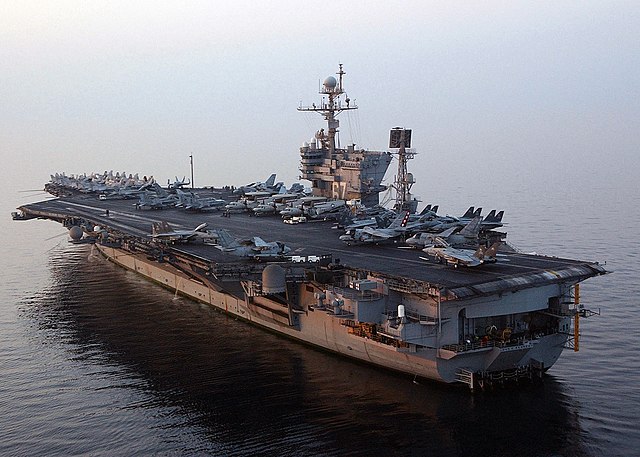
USS John F. Kennedy port stern view, 2004
The sole SCB-127C carrier, and last conventional fleet carrier of the USN was completed in 1965, in the larger semi-submerged Shipway 11, and after she was christened on 27 May 1967 by Jacqueline Kennedy and her daughter Caroline, she entered service on 7 September 1968. Her new island was the most striking difference to her other sisters with its angled funnel. The way she was shorter however, was not.
After her operational readiness inspection by Commander, CarDiv 2, CV-67 left for her first Mediterranean TOD in April 1969. She called Rota on 22 April, relieving USS Forrestal. RADM of the 6th fleet Pierre N. Charbonnet, Carrier Striking Forces and CSU (Carrier Striking Unit) 60.1.9 made her his flagship and she transited Gibraltar, refueled from USS Marias, shadowed by the Soviet Kotlin-class destroyer No. 383. Fo her maiden voyage and later deployments it’s the Middle East which became the focus and she was upgraded to handle the F-14 Tomcat and the S-3 Viking like her sisters in the 1970s.
She was mobilized to keep watch over the Yom Kippur war in October 1973. In In 1974, she won the Marjorie Sterrett Battleship Fund Award for the Atlantic Fleet. On 20 June 1975 there was an arson aboard, with eight fires starting, but no injuries while in Norfolk. Like her sisters, the main Atlantic home port. On 22 November 1975 she collided with the guided missile cruiser USS Belknap, and suffered far less than her sister. JP-5 fuel lines however ruptured and sprayed in the catwalk, fires starting on both vessels. Belknap’s superstructure burned to a crisp and she lost seven in the inferno. John F. Kennedy’s crew modelty suffered from smoke inhalation, and Yeoman 2nd Class David A. Chivalette (VF-14, CVW-1) died as a result.
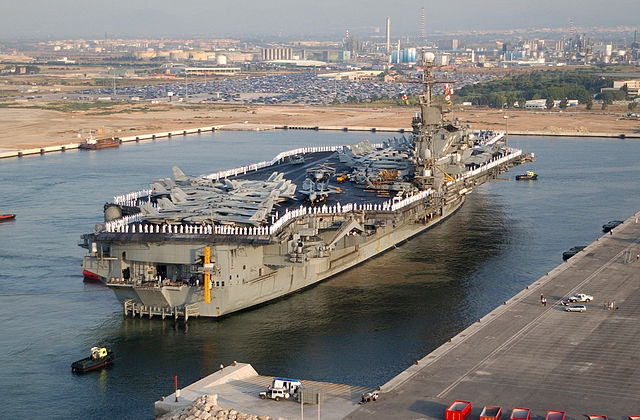
Port Visit in Spain
In the night of 14-15 September 1976, while underway for a replenishment north of Scotland, USS Bordelon lost control, collided with CV-67. Again, the destroyer was in such state that she was scrapped at home. It was insignificant for thr carrier, ater repaied in Norfolk. She lost a F-14 Tomcat due to a catapult was lostr but the crew ejected and survived. As often in that case, the parachute never had the time to deploy and they basically both crashed on deck, being injured. The always nearby Soviet Navy rushed to seize the sinking planen carrying brand new missiles. Eventually, the US Navy managed to retrieve it.
In 1979 John F. Kennedy had her first long overhaul, completed in 1980 at Norfolk NyD while arson attacks were carried out on the ship on two occasions. On 9 April five fires killed a shipyard worker, injured 34 and another on 5 June, two more firesbut no injuries. After the usual post-refit trials and refrsher cruise she was back in the Atlantic, winning her second Marjorie Sterrett Battleship Fund Award. On 4 August 1980, she departed for the Mediterranean, with nothing to note.
On 4 January 1982, she operated with Carrier Air Wing Three as flagship, Carrier Group Four (CCG-4) for her ninth Mediterranean deployment this time completed by a Suez canal crossing and Indian Ocean, visiting Austrlia and Perth, Fremantle, and dropping anchors in Gage Roads, 19 March 1982. On 25 March she was back in the Indian Ocean and visited Somalia, then Mombasa, and Toulon, France before calling for Malaga in Spain and Nortfolk on 14 July. October 1983 saw her taking station off Beirut, Lebanon instead of her usual Indian Ocean deployment after a bomving of US personnel of the Multinational Force and she kept patrolling the aread.
On 4 December she launched her first strioke against Hezbollah positions in Beirut, ten A-6 aircraft in addition to others from USS Independence. This was a retaliation for two F-14 being fired upon. She lost an A-6E by SAMs provided by Iran. The pilots became POWS, released on 3 January 1984.
In 1984, she was in maintenance in Norfolk with overhault and improvements lasting for a year and a half. Sge was back in operation in late 1985, receiving the DoD Phoenix Award for Maintenance Excellence. In July 1986, she took part in an International Naval Review during the re-dedication and maintenance of the Statue of Liberty. in NyC, acting as flagship. In August she was back in the Mediterranean for Freedom of Navigation exercises in the Gulf of Sidra, Lybia. She also retook her station in Lebanon due to terrorist activities and Beirut’s hostage crisis. She was back in Norfolk in March 1987 for 15 months or iverhaul and upgrades.
In August 1988 she started her 13th deployment, at some point two Lybian MiG-23 Flogger approached the task force 81 miles (130 km) off shore and CV-67 launched two F-14 Tomcats (VF-32 “Fighting Swordsmen”) in interception, sending them away and she shot them down.
She later took part in Fleet Week, New York and Independence Day celebrations in Boston. On 10 August 1990, she was called to participate to Operation Desert Shield. She needed SRA maintenance which was done way faster than usual, in just 24-hour as well as additional fuel and ordnance before rushing in the Atlantic on 15 August as flagship, Red Sea Battle Force.
At midnight, 17 January 1991 Carrier Air Wing 3 launched its very first strike and until the cease-fire, 114 were launched, 2,900 sorties, dropping some 3.5 million pounds of ordnance. In late February order to stand down was received and she was relieved, taking the Suez Canal to be back in Norfolk on 28 March. Maintenance started with focus on the worn-out flight deck, and careful examination of many critical system and replacements while she was refitted to operate the F/A-18C/D Hornet. After he usual post-refot trials and refresher cruise in the Carribean, she departed for her 14th Med TOD and this time took position off Yugoslavia, for the Bosnia-Herzegovina war, enforcing the no fly zone with UN.
Back home, she entered the Philadelphia Naval Shipyard, for a 2-year extensive overhaul (not SLEP), and she was transferred to Mayport NAS near Jacksonville, her new and final home port. By 1 October 1995, she became a reserve carrier with only partial full-time active duty on the Atlantic Fleet. She could be reactivated for war operations or relieve other carriers but in peacetime acted with a small reserve crew and support training requirements. She still took pat in routine fleet exercises and aviator carrier qualifications, even battle group training.
Lacking funds however, the naval Reserve failed to carry out a proper maintenance and John F. Kennedy’s general state degraded. Air Wing Reserve 30 was soon eliminated and the carrier was devoid of any planes since Carrier Air Wing Reserve 20 was also reduced drastically. After the 11 September 2001 attacks however, the Operational Reserve Carrier ended. John F. Kennedy was made fully operational again with a thorough maintenance. She visited Dublin for the first tiime in 1996 visited by some 10,000 while at anchor in Dublin Bay and greeted by American-Irish personalities.
She made afterwards her 15th Mediterranean deployment and transited Suez for four months of station in the Persian Gulf. Two Iranian F-14s arrived by night at low altitude and high speed, detected by the AEGIS cruiser USS Vicksburg and warned. They turned away. CV-67 also took part in Fleet Week ’98 in New York and made her 16th deployment, making a salvage and rescue during Hurricane Floyd by mid-September 1999. She stopped in Al Aqabah, Jordan, vbing visited by the King of Jordan, and took part in Operation Southern Watch. She was the last conventional fleet carrier of the USN when arriving in Mayport on 19 March 2000.
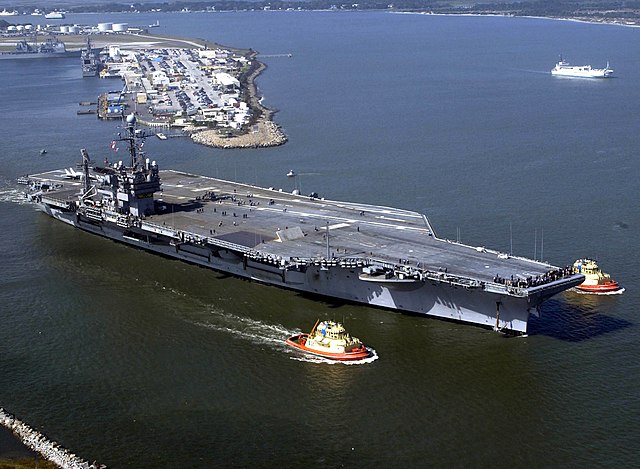
USS_John_F_Kennedy_CV-67_departs_Naval_Station_Mayport_on_11_November_2003
After maintenance and the Advanced combat direction system being fitted, she participated in the 4 July International Naval Review, followed by an appearance in Sail Boston 2000. During her last refit she became a testbed for the Cooperative Engagement Capability system using satecom to engage targets beyond range. In 2001 on trials shortcoming were found in air group operations and catapults, elevators, were found non-functional while two boilers refused to start, resulting on a degraded note while both her captain and two department heads were relieved for failing maintenance.
Her last major operations was Noble Eagle in the mid-Atlantic seaboard, ending on 14 September 2001, and for the first six month of 2002, she launched airstrikes over Afghanistan, spending some 31,000 tons of ordnance at al Qaeda targets for Operation Enduring Freedom. While back home she stopped in Tarragona, and Rota as usual. In July 2004 she collided with a dhow in the Persian Gulf and due to the incident the commanding officer was relieved. While trying to avoid the vessels, turning hard at high speed, she had three planes damaged by collisions, as she was recovering an aircraft critically low on fuel.
Ans assessment was made when back home and it appeared CV-67 was the costlier carrier to maintain and operate in the fleet, expected to have another expensive overhaul, but budget cutbacks instead urged her retirement, announced on 1 April 2005. She made her last training cruise on the East Coast and stopped in NYC for Fleet Week, visited Boston, and was decommissioned in Mayport. She made a last serie of farewell port calls along the way to her reserve site, including Boston before her decommission on 23 March 2007.
Her in-port cabin decorated by Jacqueline Kennedy was saved, disassembled and rebuilt at the National Museum of Naval Aviation, NAS Pensacola.
She was towed to Norfolk on 26 July 2007, until Pier 4 in Philadelphia was dredged for her to dock and on 17 March 2008 she left Norfolk with the tug Atlantic Salvor and arrived on 22 March at high tide at the Naval Inactive Ship Maintenance Facility of Philadelphia. By November 2009, she was on donation hold as museum/memorial, which passed Phase II in 2010, but eventually the Maine City Council refused to host the ship. By late 2017 her donation hold status was revoked and she was to be sold for BU, on 6 October 2021 together with USS Kitty Hawk to International Shipbreaking Limited. The dismantling process is still ongoing today.

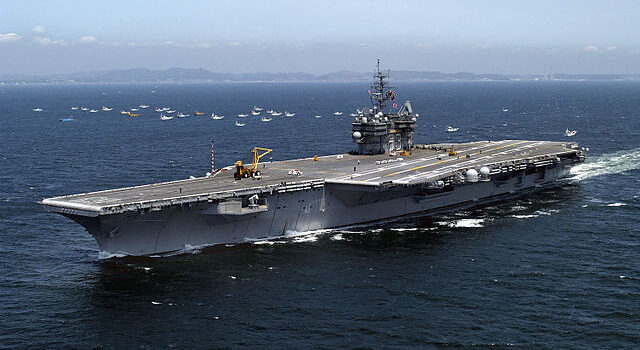
















 Latest Facebook Entry -
Latest Facebook Entry -  X(Tweeter) Naval Encyclopedia's deck archive
X(Tweeter) Naval Encyclopedia's deck archive Instagram (@navalencyc)
Instagram (@navalencyc)





 French Navy
French Navy Royal Navy
Royal Navy Russian Navy
Russian Navy Armada Espanola
Armada Espanola Austrian Navy
Austrian Navy K.u.K. Kriegsmarine
K.u.K. Kriegsmarine Dansk Marine
Dansk Marine Nautiko Hellenon
Nautiko Hellenon Koninklije Marine 1870
Koninklije Marine 1870 Marinha do Brasil
Marinha do Brasil Osmanlı Donanması
Osmanlı Donanması Marina Do Peru
Marina Do Peru Marinha do Portugal
Marinha do Portugal Regia Marina 1870
Regia Marina 1870 Nihhon Kaigun 1870
Nihhon Kaigun 1870 Preußische Marine 1870
Preußische Marine 1870 Russkiy Flot 1870
Russkiy Flot 1870 Svenska marinen
Svenska marinen Søværnet
Søværnet Union Navy
Union Navy Confederate Navy
Confederate Navy Armada de Argentina
Armada de Argentina Imperial Chinese Navy
Imperial Chinese Navy Marinha do Portugal
Marinha do Portugal Mexico
Mexico Kaiserliche Marine
Kaiserliche Marine 1898 US Navy
1898 US Navy Sovietskiy Flot
Sovietskiy Flot Royal Canadian Navy
Royal Canadian Navy Royal Australian Navy
Royal Australian Navy RNZN Fleet
RNZN Fleet Chinese Navy 1937
Chinese Navy 1937 Kriegsmarine
Kriegsmarine Chilean Navy
Chilean Navy Danish Navy
Danish Navy Finnish Navy
Finnish Navy Hellenic Navy
Hellenic Navy Polish Navy
Polish Navy Romanian Navy
Romanian Navy Turkish Navy
Turkish Navy Royal Yugoslav Navy
Royal Yugoslav Navy Royal Thai Navy
Royal Thai Navy Minor Navies
Minor Navies Albania
Albania Austria
Austria Belgium
Belgium Columbia
Columbia Costa Rica
Costa Rica Cuba
Cuba Czechoslovakia
Czechoslovakia Dominican Republic
Dominican Republic Haiti
Haiti Hungary
Hungary Honduras
Honduras Estonia
Estonia Iceland
Iceland Eire
Eire Equador
Equador Iran
Iran Iraq
Iraq Latvia
Latvia Liberia
Liberia Lithuania
Lithuania Mandchukuo
Mandchukuo Morocco
Morocco Nicaragua
Nicaragua Persia
Persia San Salvador
San Salvador Sarawak
Sarawak Uruguay
Uruguay Venezuela
Venezuela Zanzibar
Zanzibar Warsaw Pact Navies
Warsaw Pact Navies Bulgaria
Bulgaria Hungary
Hungary

 Bundesmarine
Bundesmarine Dutch Navy
Dutch Navy Hellenic Navy
Hellenic Navy Marina Militare
Marina Militare Yugoslav Navy
Yugoslav Navy Chinese Navy
Chinese Navy Indian Navy
Indian Navy Indonesian Navy
Indonesian Navy JMSDF
JMSDF North Korean Navy
North Korean Navy Pakistani Navy
Pakistani Navy Philippines Navy
Philippines Navy ROKN
ROKN Rep. of Singapore Navy
Rep. of Singapore Navy Taiwanese Navy
Taiwanese Navy IDF Navy
IDF Navy Saudi Navy
Saudi Navy Royal New Zealand Navy
Royal New Zealand Navy Egyptian Navy
Egyptian Navy South African Navy
South African Navy






























 Ukrainian Navy
Ukrainian Navy dbodesign
dbodesign